Green caterpillars are one of the most recognizable (and often unwanted) visitors to your garden, and are often found munching on the leaves of various ornamental and edible plants, shrubs, and trees.
For the most part, caterpillars are harmless to humans but some may cause skin irritations when touched, or even spit acid in defense! So, it’s a good idea to identify any green caterpillar first before attempting to hand-pick it.
If you want to know what you’re dealing with, this A to Z guide will take you through the 32 most common green caterpillars in your yard and how to identify them by their size, markings, spines or spikes, the plants they usually feed on, and the types of butterflies they turn into.
Disclosure: If you shop from my article or make a purchase through one of my links, I may receive commissions on some of the products I recommend.
How to identify green caterpillars
Caterpillars are the larvae of various species of moths or butterflies. When identifying a green caterpillar, it’s important to remember that caterpillars go through multiple molts and life stages (known as instars) and may not always look like the pictures below.
Young caterpillars may be lighter in color or have different markings and other physical characteristics (such as stripes, spikes, or horns) than mature caterpillars, which often turn brown right before they pupate. So besides appearance, consider the type of plant it’s crawling or feeding on to help you determine what kind of caterpillar is in your garden.
Related: How to identify the most common striped caterpillars in your yard
For ease of ID, the pictures and descriptions below are of mature caterpillars before they enter pupation.
Recommended products for caterpillar control:
- Bonide Caterpillar Thuricide Spray
- Monterey Bacillus Thuringiensis (B.t.) for Organic Gardening
- Safer Brand Bacillus Thuringiensis (B.t.) Concentrate for Caterpillars
- Bonide Captain Jack’s Dead Bug Brew Garden Dust
Common types of green caterpillars
Angle shades moth caterpillar
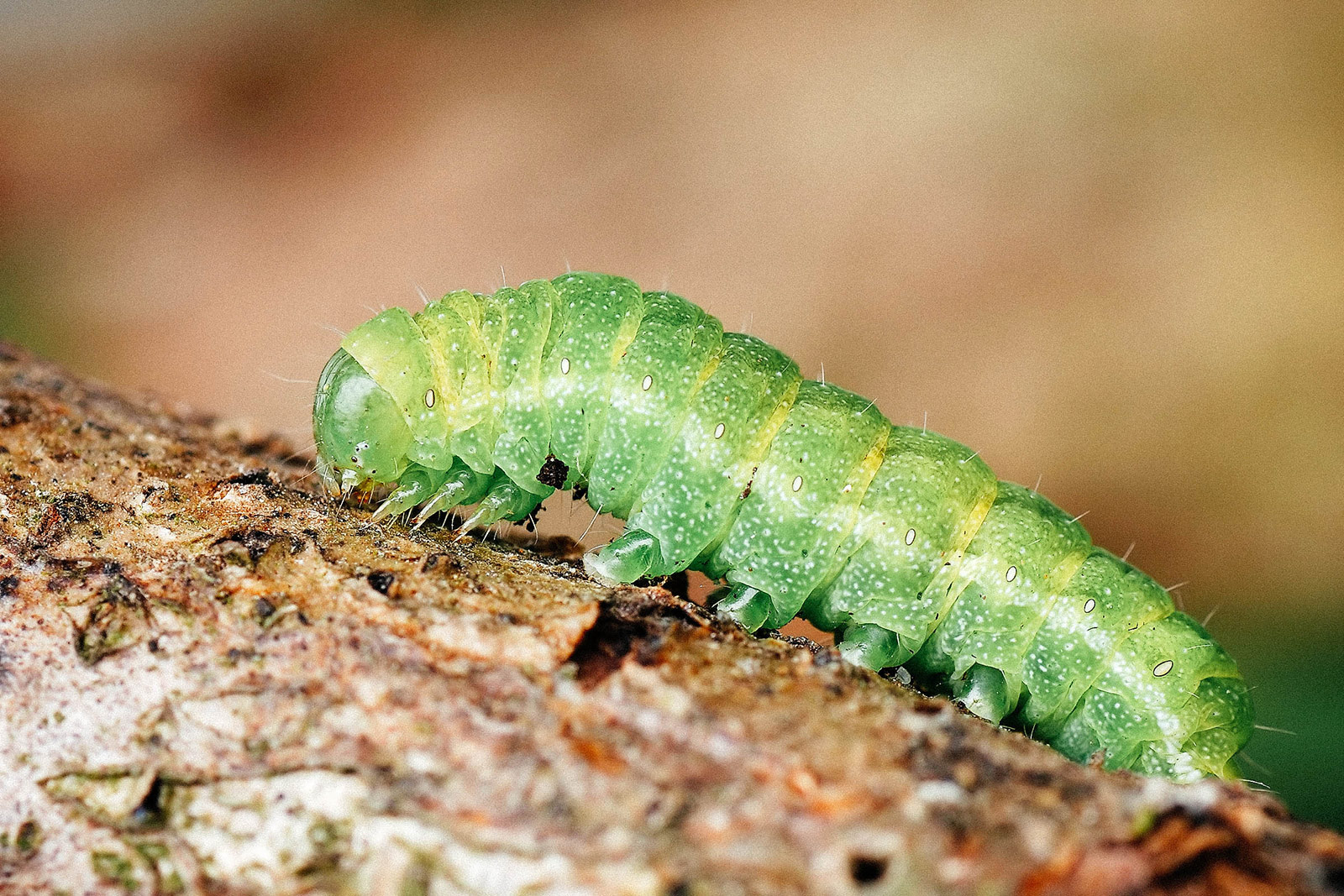
- Scientific name: Phlogophora meticulosa
- Turns into: Angle shades moth
- Found in: Europe, Algeria, Asia Minor, Armenia, and Syria
The angle shades caterpillar is a member of the Noctuidae family and is relatively small compared to other types of caterpillars. Its coloring is green with a layer of white lines running down the sides, but there can also be instances where the skin is brownish-green with red spots running down the sides alongside the lines.
Host plants for angle shades larvae include common nettles, hops, docks, red valerian, hazel, brambles, birches, and oaks.
Black swallowtail caterpillar
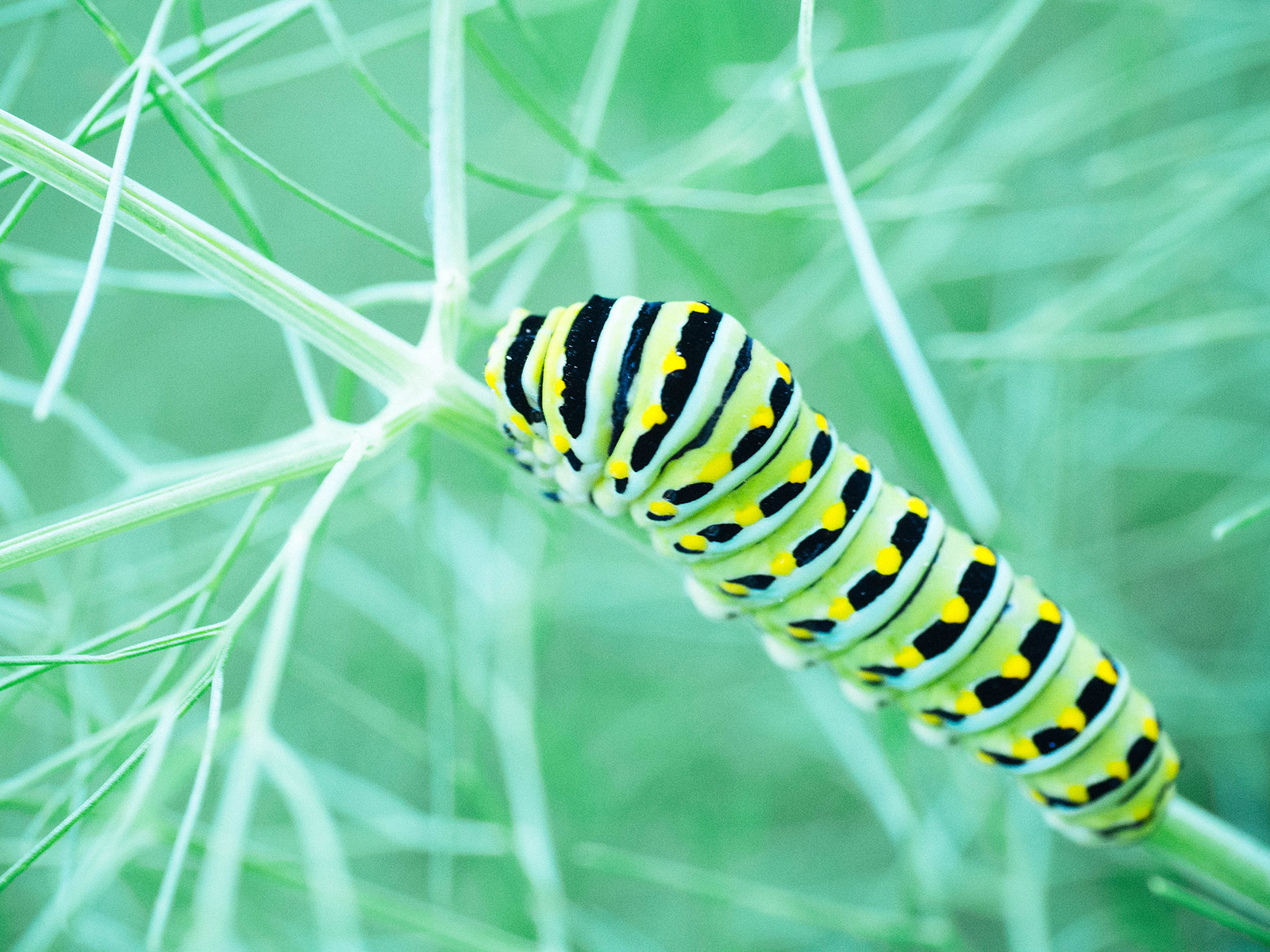
- Scientific name: Papilio polyxenes
- Turns into: Black swallowtail butterfly
- Found in: Southern Canada, most of the eastern and midwestern United States west to the Rocky Mountains, and southwest into Arizona and northern Mexico
The black swallowtail caterpillar is a species that changes color as it matures. Young caterpillars are black with white saddles, but mature into a bright green color layered with black stripes down the sides.
The stripes can also have yellow dots on top of them which makes this species one of the easiest to identify thanks to its striking features. These colors grow closer together and meet at the head of the caterpillar.
The black swallowtail caterpillar has a glandular defense mechanism (called an osmeterium) on its head to protect against predators. The osmeterium resembles an orange forked tongue and can be everted (turned inside out) when the caterpillar feels threatened, releasing a foul odor that kind of smells like rancid citrus.
If you’re unsure whether you’ve come across a black swallowtail caterpillar, you can gently squeeze the front part of the body and see if the osmeterium pops out—but keep in mind this can release an odor.
Black swallowtail larvae feed on carrot tops, parsley, dill, fennel, Queen Anne’s lace, and rue.
Cabbage looper caterpillar
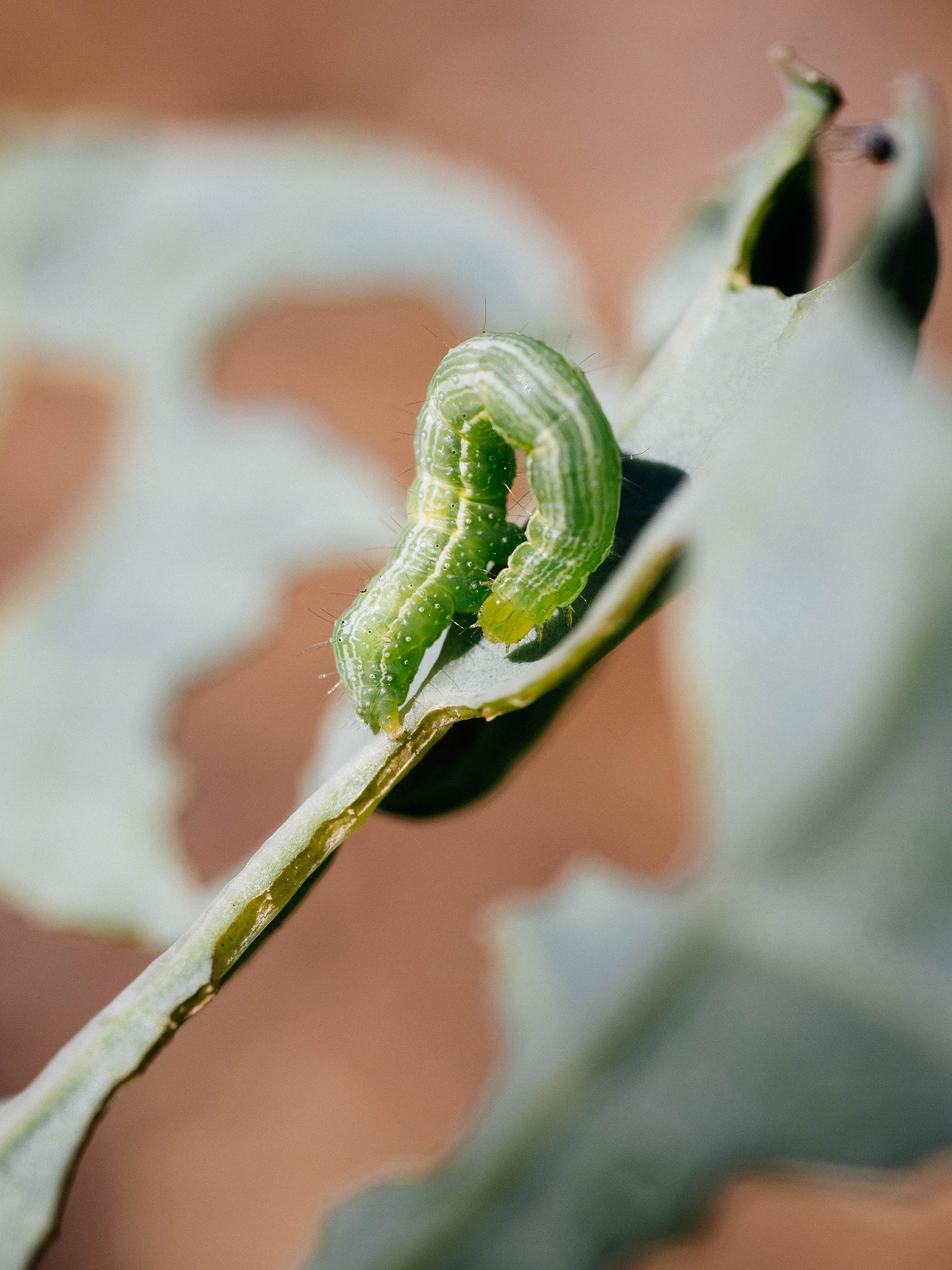
- Scientific name: Trichoplusia Ni
- Turns into: Cabbage looper moth
- Found in: North America
The cabbage looper caterpillar can easily be identified by its distinctive movement: It arches its back or “loops” as it inches along. Its appearance is characterized by fine hairs (almost like peach fuzz) that grow on the entire surface of the body.
Cabbage loopers can grow to be around 4 centimeters (1.5 inches) and they are ferocious feeders, eating plant materials that weigh three times their own body weight. This makes them one of the most serious and destructive garden pests, and very hard to get rid of once established.
True to their name, the larvae feed on cabbage and other members of the brassica family, including kale, broccoli, brussels sprouts, and turnips. However, cabbage loopers may also attack spinach, lettuce, celery, cucumbers, and tomatoes in the absence of cruciferous plants, as well as strawberries that are planted near leafy greens.
Cabbage white caterpillar (imported cabbageworm)
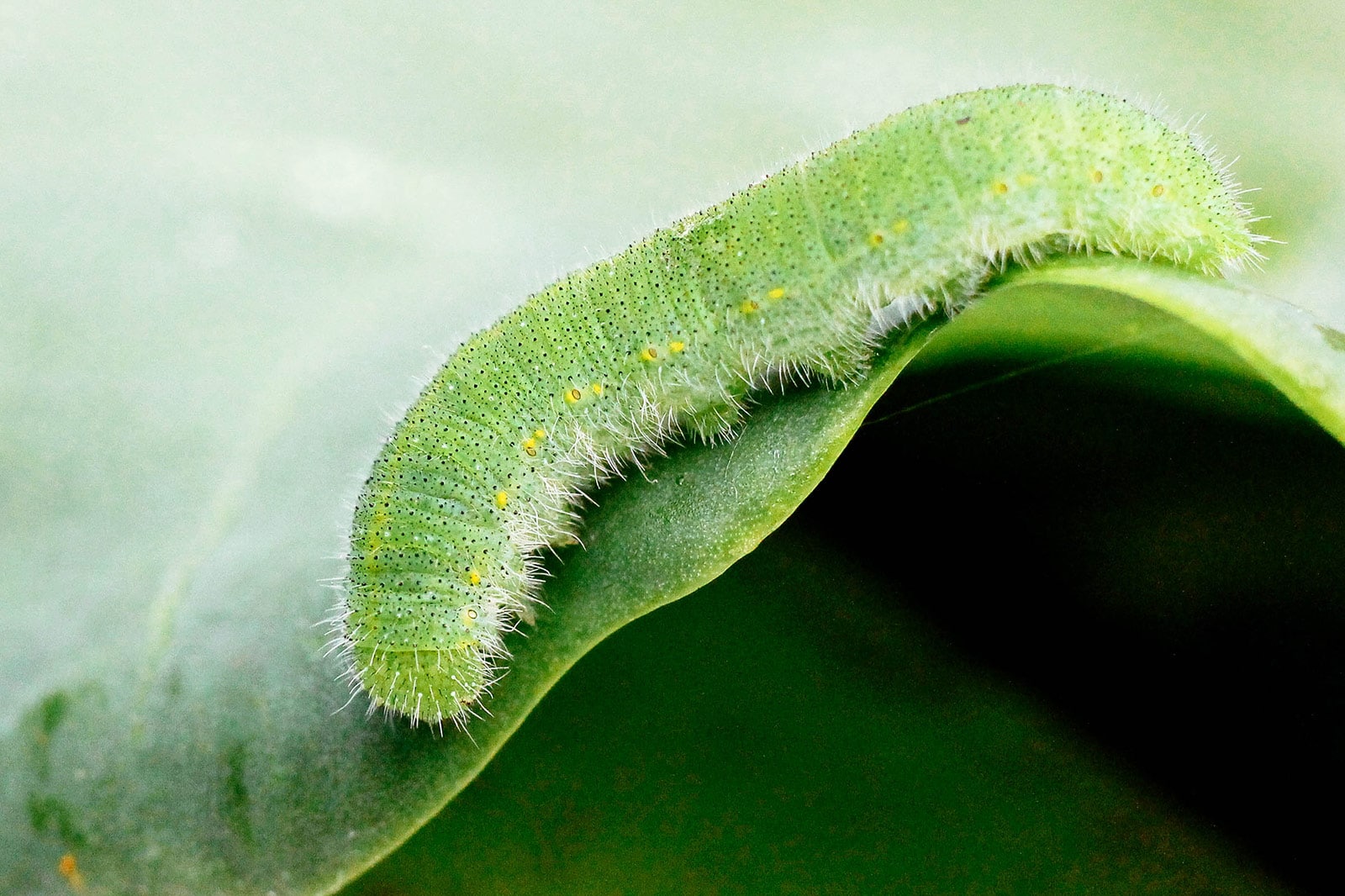
- Scientific name: Pieris rapae
- Turns into: Cabbage white butterfly
- Found in: North America, Europe, Asia, and north Africa
The cabbage white caterpillar (also known as the imported cabbageworm) is one of the most common kinds of caterpillars that you’ll come across. Often found in gardens munching on all sorts of vegetables such as broccoli, cabbage, kale, and bok choy, this caterpillar’s body is smooth, slender, and light green in color.
Cabbage white larvae are voracious eaters, which can be a huge problem for gardeners who like to grow brassicas. Just a handful of these caterpillars can decimate an entire crop in a matter of days!
Though they’re sometimes mistaken for cabbage loopers (another type of caterpillar that feeds on brassicas), cabbage white caterpillars do not double up as they crawl.
The majority of cabbage white caterpillars are completely light green, but others may also have yellow coloring or yellow markings.
Cecropia moth caterpillar

- Scientific name: Hyalophora cecropia
- Turns into: Cecropia moth
- Found in: Nova Scotia (eastern Canada) and Maine south to Florida, and west to the Canadian and US Rocky Mountains
The cecropia moth caterpillar is one of the easiest caterpillars to identify because of its impressive size and striking appearance. It begins life as a yellow or light green caterpillar, gradually maturing into a blue-green color.
This caterpillar has a ridged appearance that’s layered with blue, orange, and yellow protuberances across the entire body as well as small black spikes that act as a defense mechanism against predators. The blue protuberances are often found running the length of each side.
Cecropia moth larvae are exceptionally large and can grow to be around 10 centimeters (4.5 inches).
The caterpillars mainly feed on apple, cherry, plum, elderberry, box elder, birch, maple, and willow, but will also feed on lilac, linden, elm, and sassafras.
Cloudless sulphur caterpillar
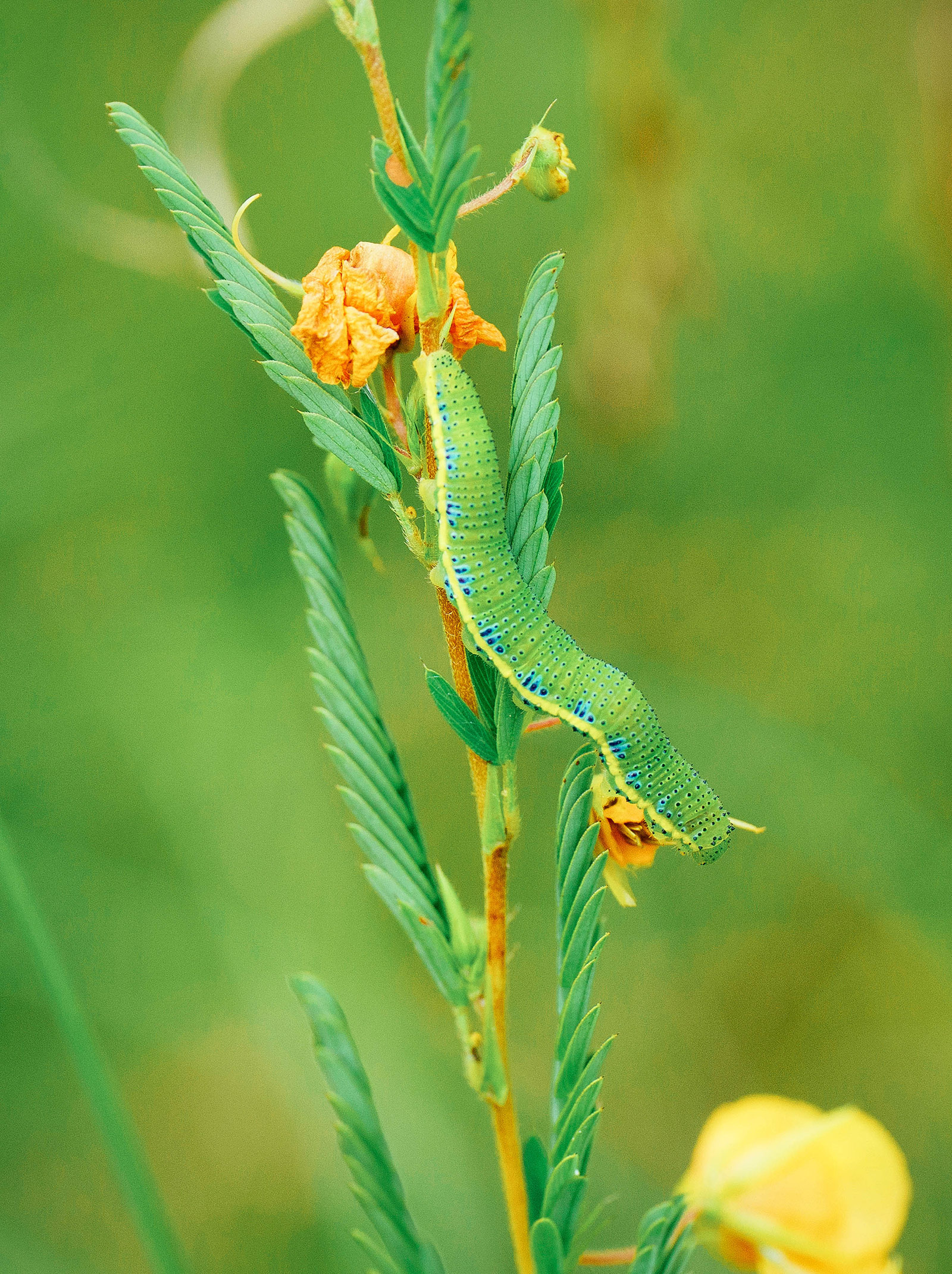
- Scientific name: Phoebis sennae
- Turns into: Cloudless sulphur butterfly
- Found in: Southern Canada (particularly southwestern Ontario) to the eastern and southern United States and south to Argentina
The cloudless sulphur caterpillar (also spelled as cloudless sulfur caterpillar) is identified by a green or yellowish-green body accompanied by blue or yellow “racing” stripes down the side, and either black or blue dots all over the body.
It also has fine hairs that grow along the body, predominantly on the feet and abdomen. This caterpillar can grow to be between 4 to 4.5 centimeters (1.6 to 1.8 inches) long, and what’s unique about this species is that its color can be altered depending on the food it eats.
For example, cloudless sulphur larvae that feed only on green foliage are usually a striking shade of green, whereas those that feed on yellow flower petals tend to turn a bright yellow.
Their host plants include sennas, partridge peas, common sensitive plants, clovers, and other legumes.
Copper underwing caterpillar
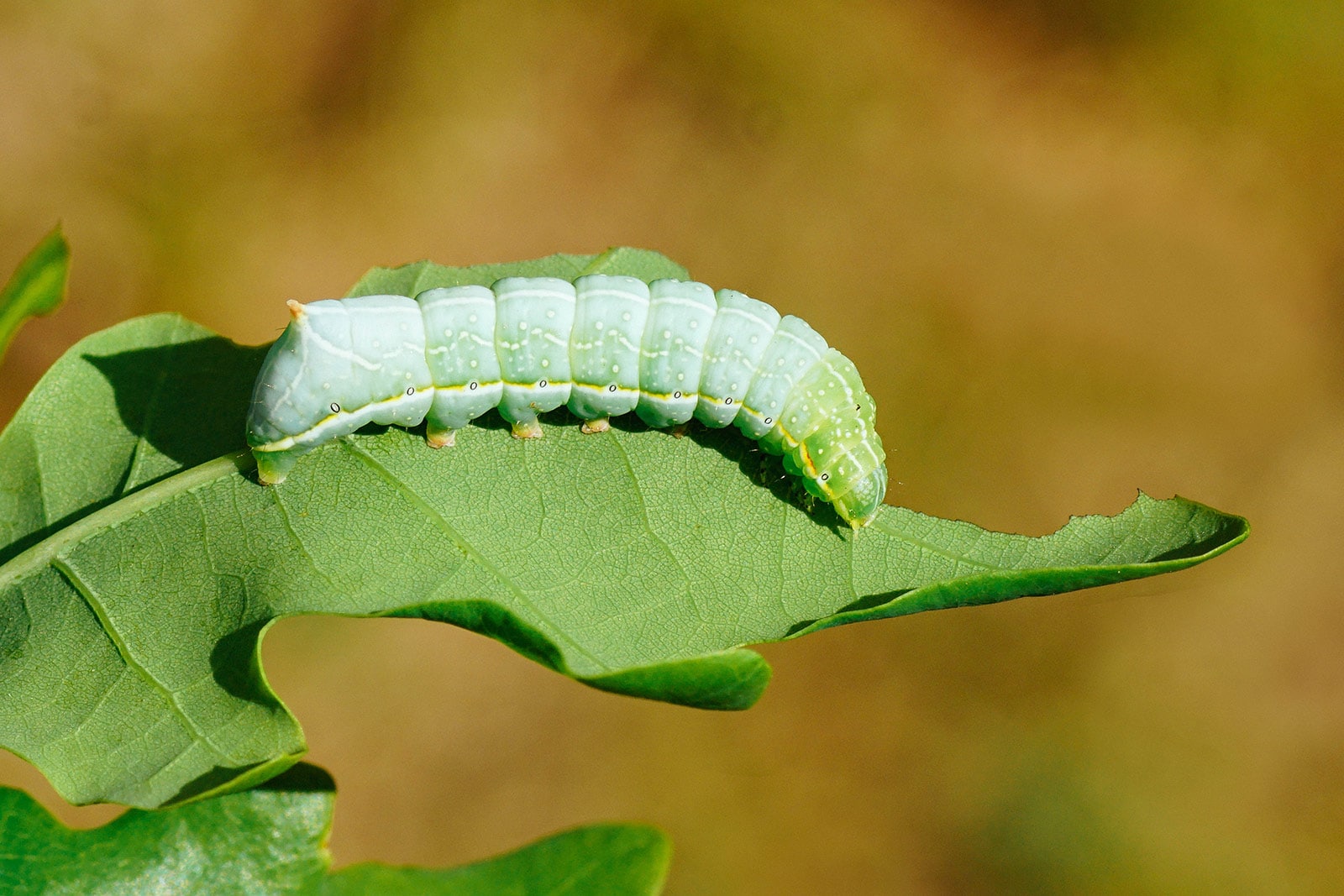
- Scientific name: Amphipyra pyramidea
- Turns into: Copper underwing moth
- Found in: United States and southern Canada
The copper underwing caterpillar is a large specimen that’s often mistaken for a hornworm (which I discuss further down this list). It has a pale green body that appears translucent during the early stages, eventually maturing into a darker green accompanied by yellow stripes along the sides and many small, scattered yellow dots.
The key identifier with this caterpillar is a large, protruding bump at the rear, and in a mature caterpillar, there’s also a colored tip that looks like a horn at the end.
Copper underwing caterpillars are plump in appearance and will lift the front part of their bodies when resting. They also have more legs than most other caterpillars: four pairs of prolegs as well as three pairs of frontal legs. This a medium-sized caterpillar, averaging less than 4.5 centimeters (1.75 inches) in length.
Larval hosts include many woody trees and shrubs, including apple, cherry, maple, oak, walnut, hawthorn, hickory, willow, basswood, blueberry, raspberry, grape, greenbrier, lilac, viburnum, and Virginia creeper.
Cross-striped cabbageworm
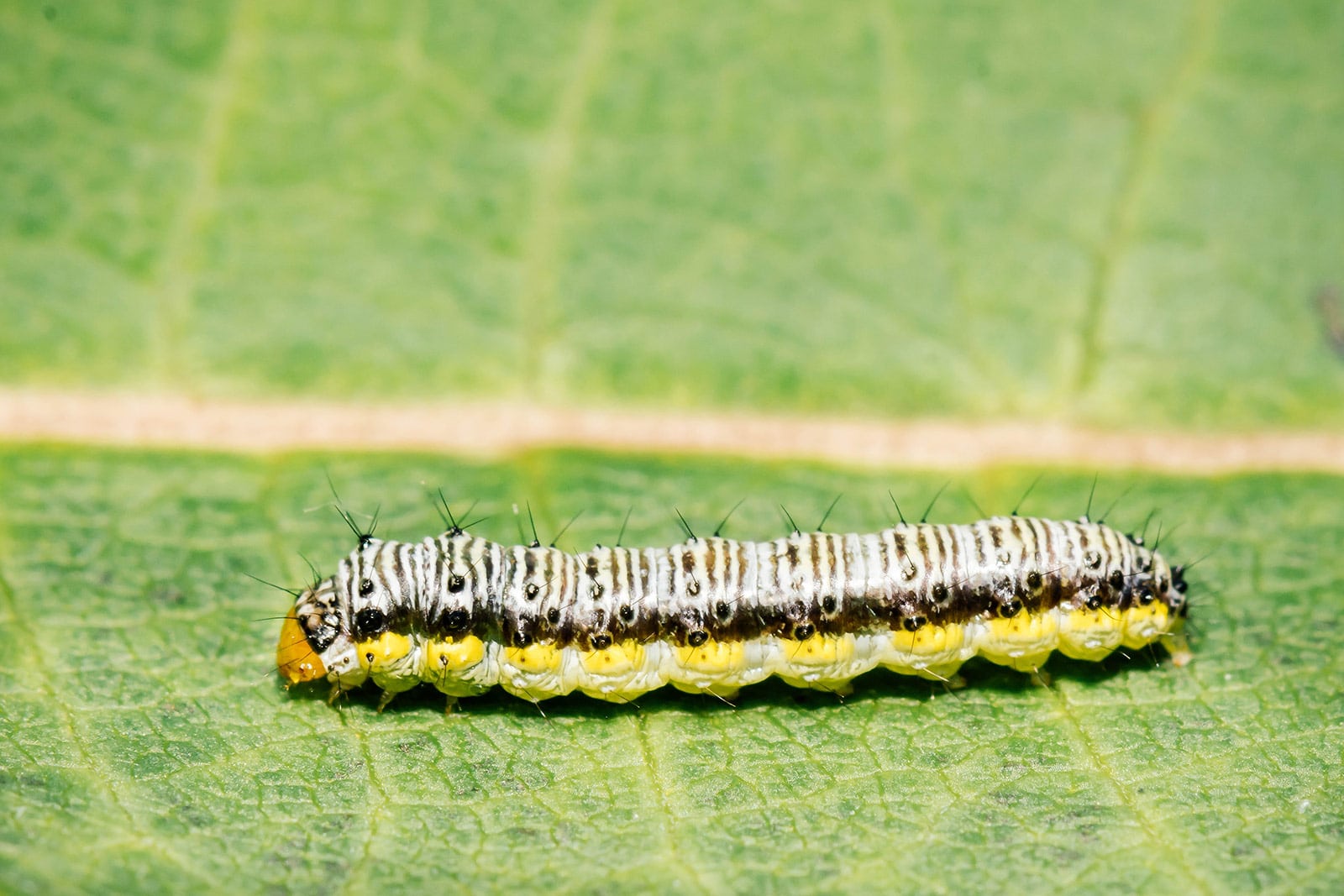
- Scientific name: Evergestis rimosalis
- Turns into: Cross-striped cabbageworm moth
- Found in: Southern New York, West Virginia, Illinois, Colorado, and Washington in the north, and from Florida to Texas and Mexico in the south
The cross-striped cabbageworm may be called a worm but it’s actually one of the three main caterpillar pests on brassica crops (the other two being cabbage white caterpillars and cabbage looper caterpillars).
It can be identified by its small body (about 1 to 1.5 centimeters, or 0.4 to 0.6 inches long) that’s bluish-green on top and light green on the bottom, with a yellow line down each side and numerous black bands across the back. It also has fine hairs all over its body.
Cross-striped cabbageworms are quite destructive, and just a few larvae can completely skeletonize a plant. They’re a serious problem for brassica crops, including broccoli, kale, cauliflower, collards, and of course, cabbage.
Crowned slug moth caterpillar
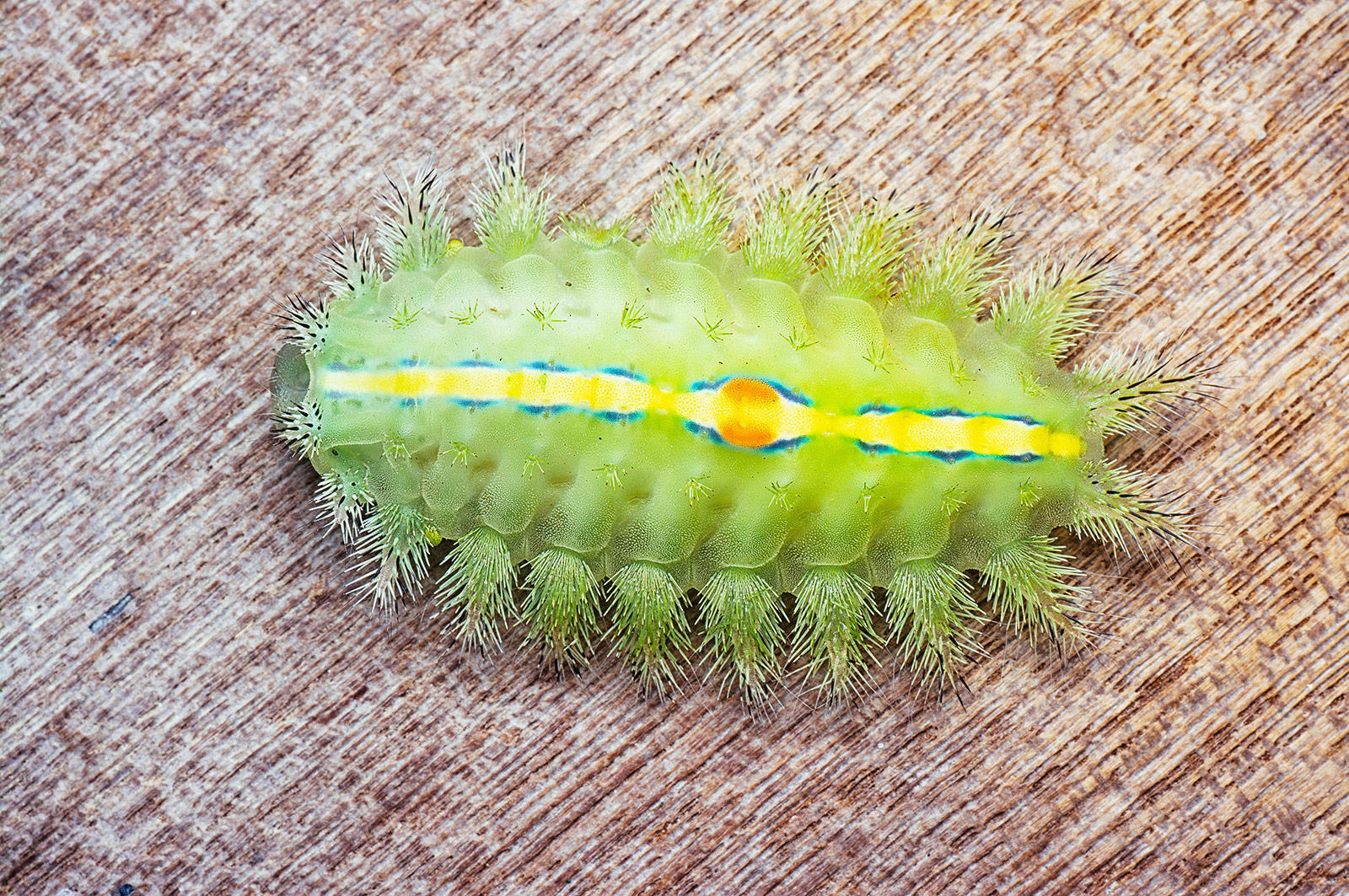
- Scientific name: Isa textula
- Turns into: Crowned slug moth (skiff moth)
- Found in: North America from Minnesota, southern Ontario and Massachusetts to Florida, Texas, and Mississippi
The crowned slug caterpillar is one of the quirkiest-looking and most exquisite caterpillars on this list, despite being relatively small (around 1.5 centimeters, or 0.6 inches, long). It’s easily identified by its distinctive oval shape with plumes of stinging hairs around the perimeter and shorter stinging hairs on top, giving it an intimidating spiky appearance.
This caterpillar also has two yellow lines down the back that terminate in a pair of “horns” on the front, along with a pair of stinging plumes on the rear. Altogether, these features help deter predators and protect the caterpillar from being eaten.
Stings from this caterpillar can irritate if you touch it, so be sure to wear gloves if you hand-pick it off your plants.
Crowned slug larvae feed on on the leaves of various trees, including cherry, oak, maple, beech, elm, and basswood.
Diamondback moth caterpillar
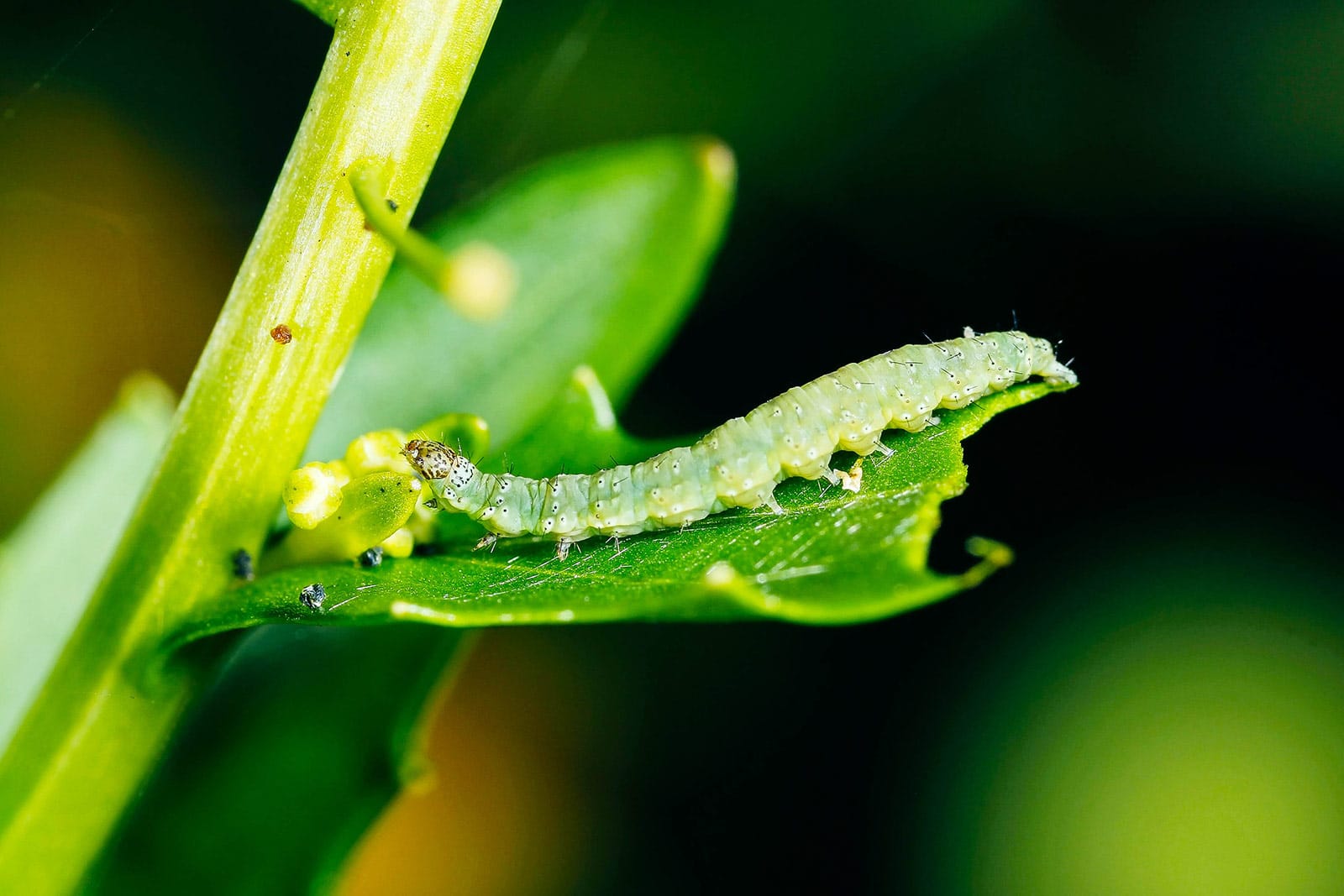
- Scientific name: Plutella xylostella
- Turns into: Diamondback moth (cabbage moth)
- Found in: The Americas and in Europe, Southeast Asia, Australia, and New Zealand
The diamondback caterpillar is one of the smallest green caterpillars you’ll come across as it’s only about 1 centimeter (0.4 inch) long.
It has a pale green body, five pairs of prolegs (with the back pair forming a V shape at the rear), and a black or brown head. The body is covered in tiny white spots with black spiny hairs coming out of them.
Diamondback larvae feed on all cruciferous vegetable crops, including brussels sprouts, collards, kale, kohlrabi, mustards, and radishes.
Since the caterpillars are so small, they often aren’t noticed right away until the damage is done. They can severely stunt the growth of brassica seedlings or disrupt head formation in cabbage, broccoli, and cauliflower.
Dragonhead caterpillar (dragon-headed caterpillar)
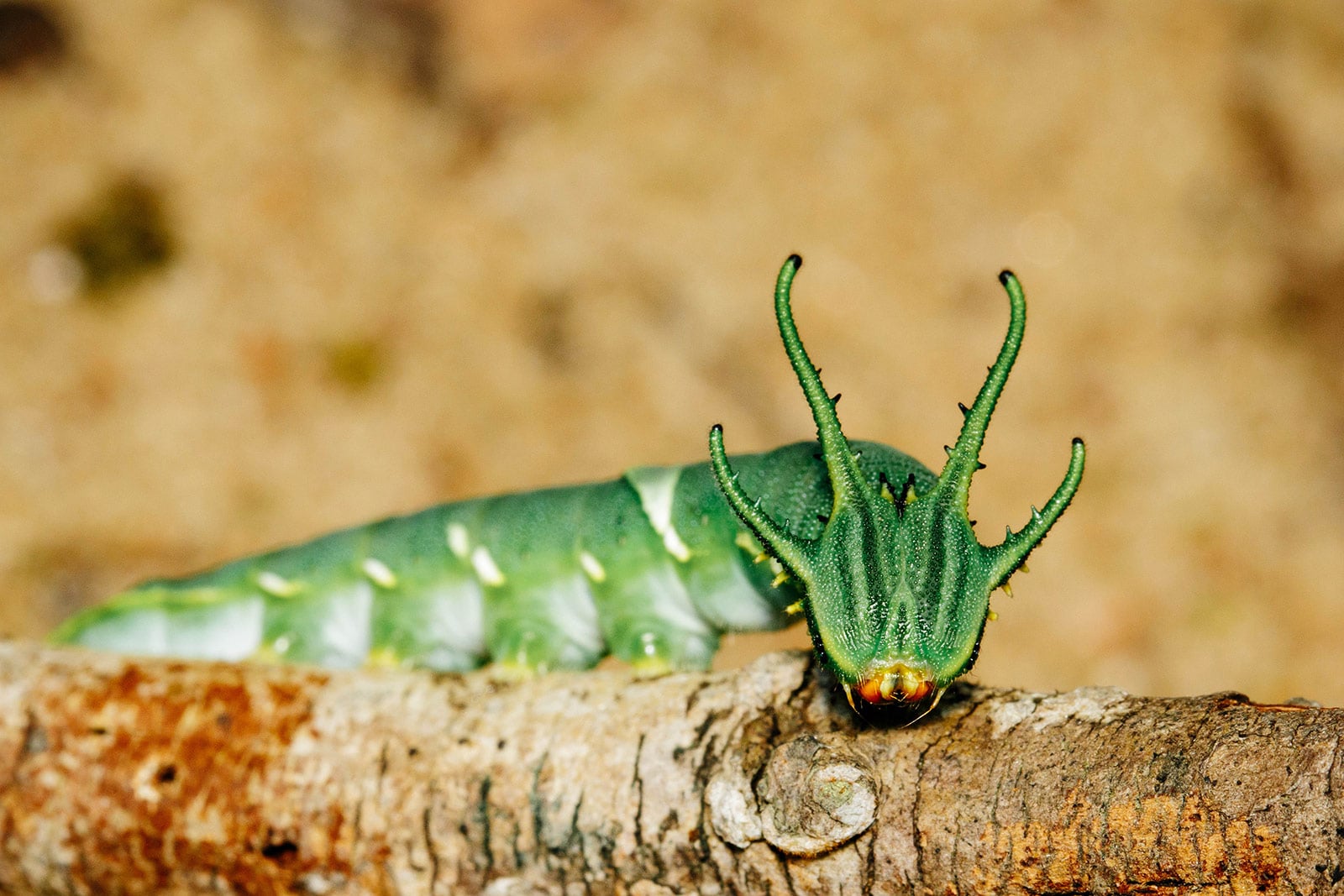
- Scientific Name: Polyura athamas
- Turns into: Nawab butterfly
- Found in: North America, Europe, China, and southern Australia
The dragonhead caterpillar (or dragon-headed caterpillar) is one of those things that looks like it could be a mythical warlord in a video game. This distinctive caterpillar has a slug-shaped, dark green body covered in a layer of spines and white and yellow stripes, often with a decorative curl on the end.
But what makes it truly captivating are the telltale “head capsules” that resemble four horns—a menacing-looking feature meant to fend off predators. Despite these intimidating horn-like projections that give the caterpillar its name, the dragonhead caterpillar is completely harmless.
What’s interesting about this particular green caterpillar is that it technically isn’t a species of its own; it’s a larval stage that’s shared among 400 species of butterflies.
That means each dragonhead caterpillar may differ slightly in appearance, with some having black heads and head capsules (that make it look like they’re wearing helmets) while others may have small red horns between the head capsules, different markings and colors, or even venomous stings if you try to pick them up.
Dragonhead larvae feed on the leaves of various members of the Fabaceae family, including acacia, black cutch, needle bush, nemu tree, copperpod, and monkeypod.
Emperor moth caterpillar
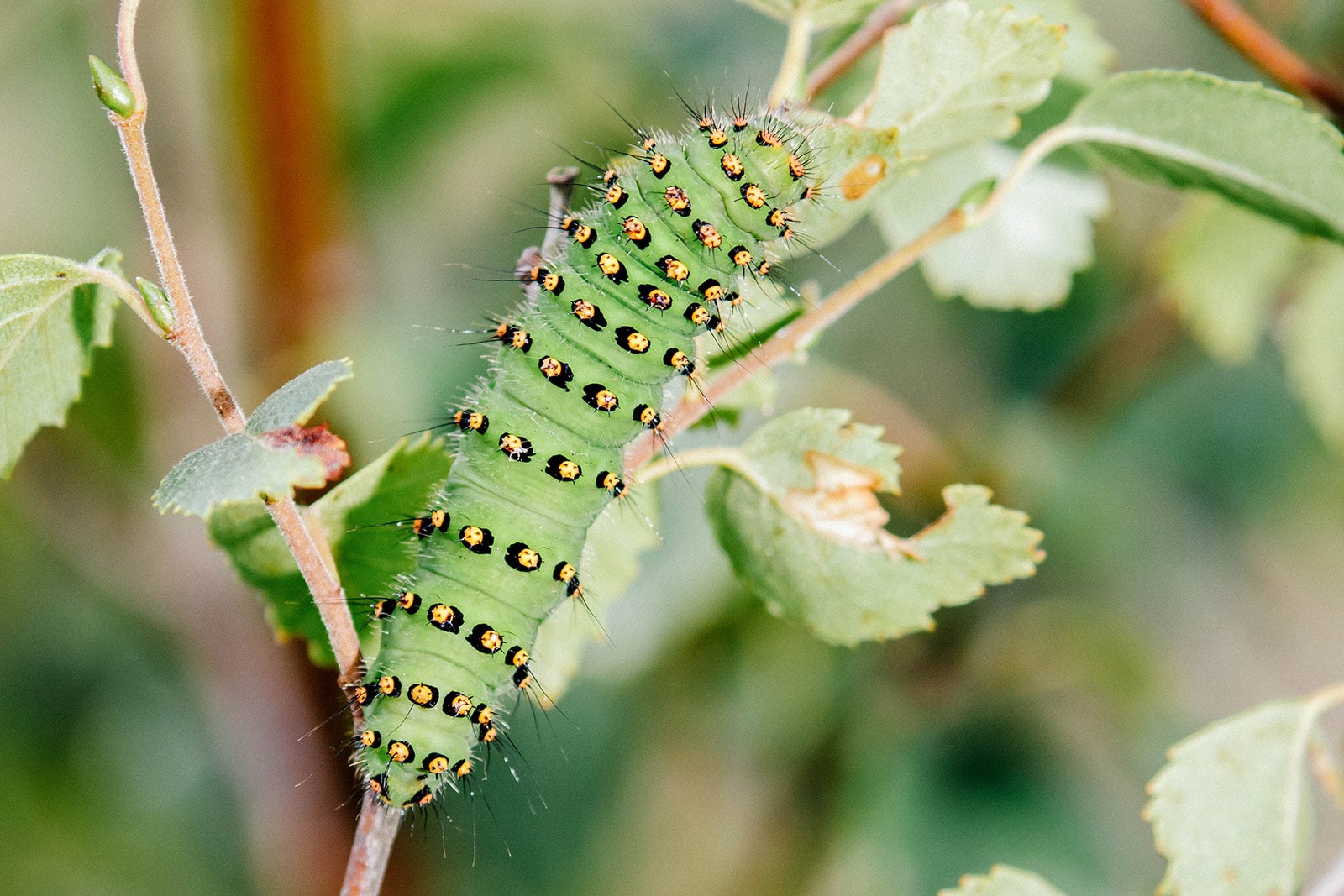
- Scientific name: Saturnia pavonia
- Turns into: Emperor moth
- Found in: Europe and Asia
As a member of the Saturniidae family, the emperor moth caterpillar is one of the largest kinds of green caterpillars you can find, growing to about 6 centimeters (2.4 inches) long.
Like most caterpillars, the emperor moth caterpillar changes color with each instar, becoming progressively greener with fine, spiky black hairs that protrude from wort-like projections all over the body.
The base of these hairs can either be white, yellow, or pink, and though this makes the caterpillars look intimidating, they are completely harmless and will not sting or poison on contact (though if you do try to pick them up, you might experience slight skin irritation).
Emperor moth larvae feed on a variety of trees and shrubs including heathers, hawthorn, meadowsweet, blackthorn, alder buckthorn, sallows, birches, brambles, and hazel.
European puss moth caterpillar
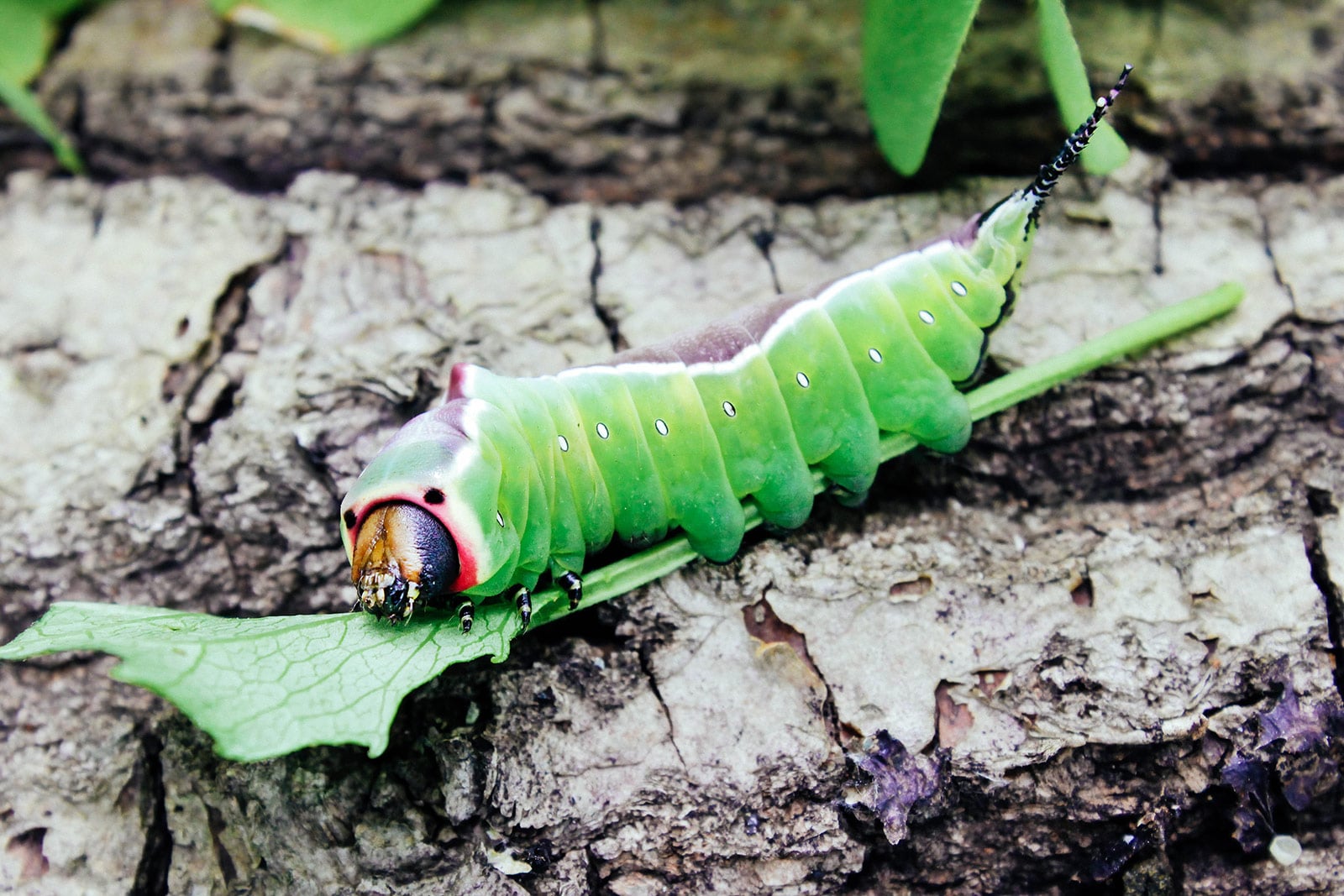
- Scientific name: Cerura vinula
- Turns into: European puss moth
- Found in: Europe, across temperate Asia to China, and north Africa
The European puss moth caterpillar has a lot of unusual things going for it: an impressively large size (growing up to 8 centimeters, or 3.1 inches, long), a bulbous head outlined in red with two black spots resembling eyes (making it look much scarier to a predator), and two whip-like black “tails” with extendable red flagellae (which wave when threatened).
Although the majority of green caterpillars are harmless, the European puss moth caterpillar is one to avoid as it can turn aggressive if you try to touch it. This caterpillar is known for spraying formic acid on you (or any attacker) in defense!
European puss moth larvae feed on the leaves of trees, preferring poplars, aspens, and willows.
Fall webworm
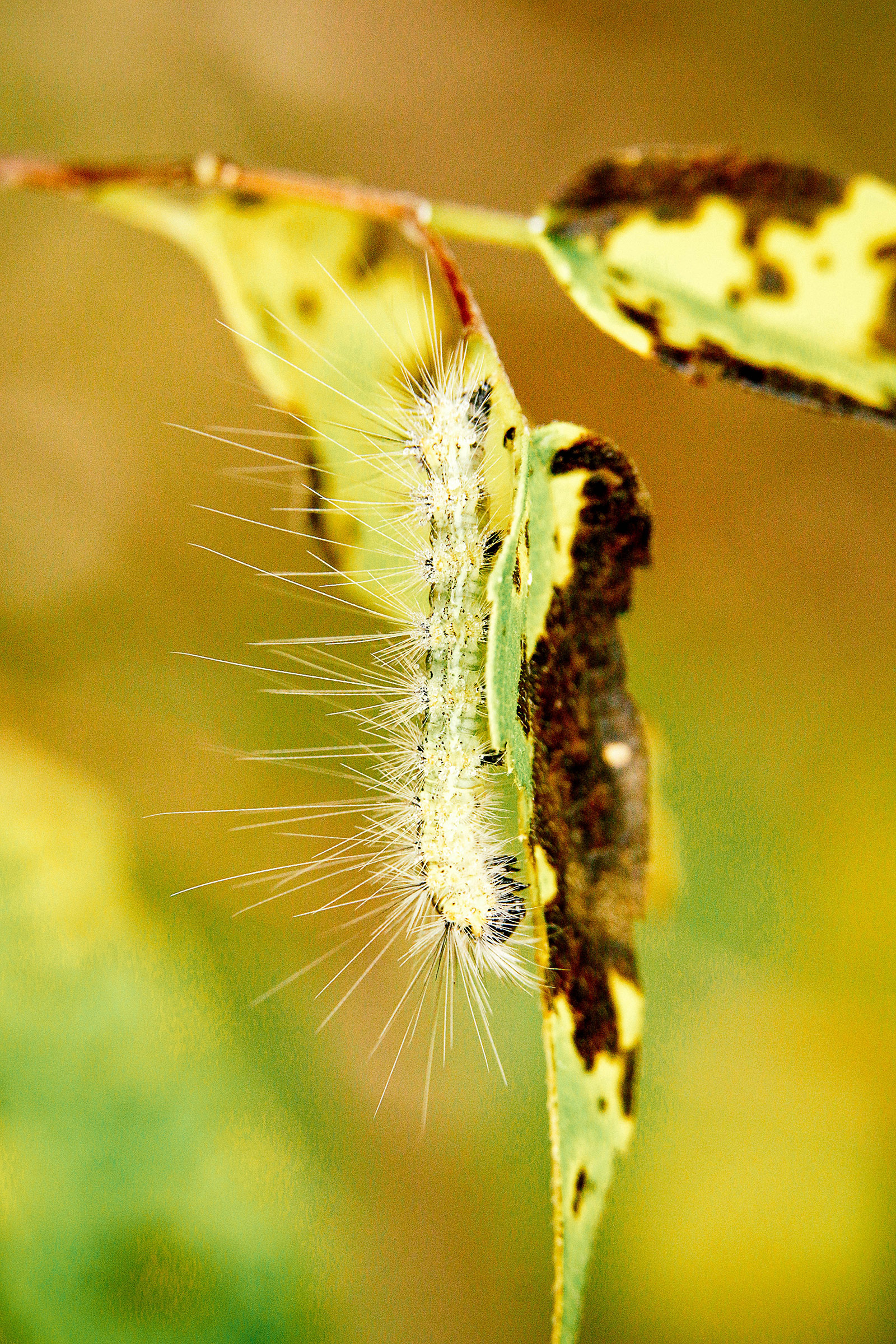
- Scientific name: Hyphantria cunea
- Turns into: Fall webworm moth
- Found in: North America, Europe, Central Asia, southern Mongolia, China, Japan, and Korea
The fall webworm is a very small green caterpillar, growing to be around 2.5 centimeters (1 inch) long. Its body is usually a shade of green with a hint of yellow, with long, thin spines that stick out over the entire surface. It is furry to the touch due to these fine hairs but is entirely harmless.
On top of the green body, you might notice a variety of black or yellow dots as well as dark gray markings spread out along the segments.
The color of the fall webworm is dependent on the environment and habitat they live in, with fully green caterpillars living in warmer climates while darker colored fall webworms are usually found in colder climates.
The fall webworm gets its name from the caterpillar’s ability to create white, silky, tent-like structures on host plants. Fall webworms are considered serious pests on ornamental and edible trees because of their ability to defoliate an entire tree.
The larvae feed on just about any type of deciduous tree, including black walnut, American elm, hickory, maple, pecan, persimmon, and other fruit trees in the eastern United States, and alder, willow, cottonwood, and fruit trees in the western United States. You’ll also find them chewing on the leaves of mulberry, madrone, and American sycamore.
Genista caterpillar (sophora worm)
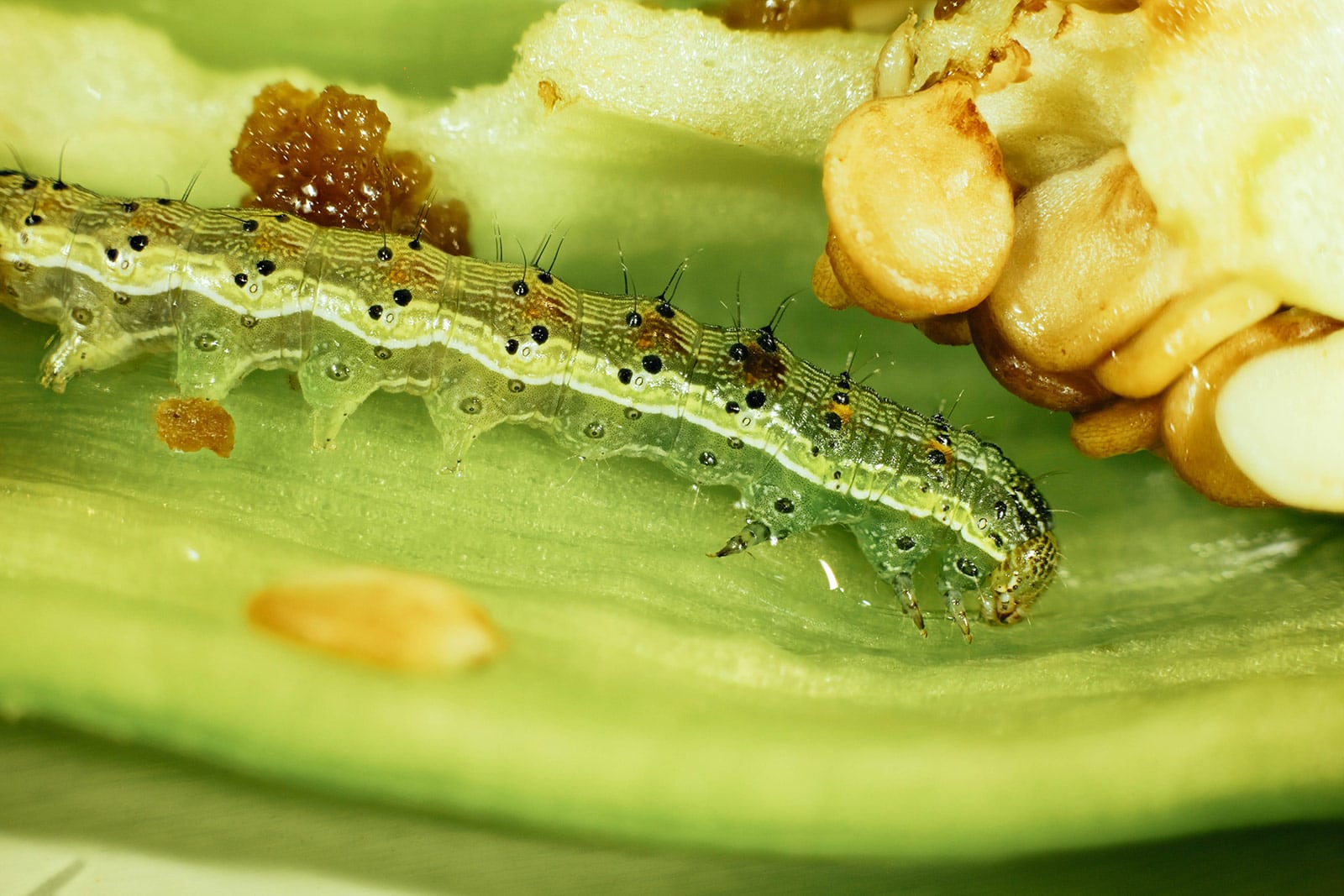
- Scientific name: Uresiphita reversalis
- Turns into: Genista broom moth
- Found in: United States, Puerto Rico, Cuba, Jamaica, Bermuda, and Mexico
The genista caterpillar (also known as the sophora worm) is identified by its yellowish-green body flecked with black and white dots. Long, fine white hairs stick out from each of these dots, giving the caterpillar a spiky appearance.
Genista broom moths are named for the plants they favor, and the larvae feed on brooms (Genista species) and Scotch broom, Texas mountain laurel (Sophora secundiflora), lupine, acacia, and blue wild indigo or false indigo.
Green cloverworm
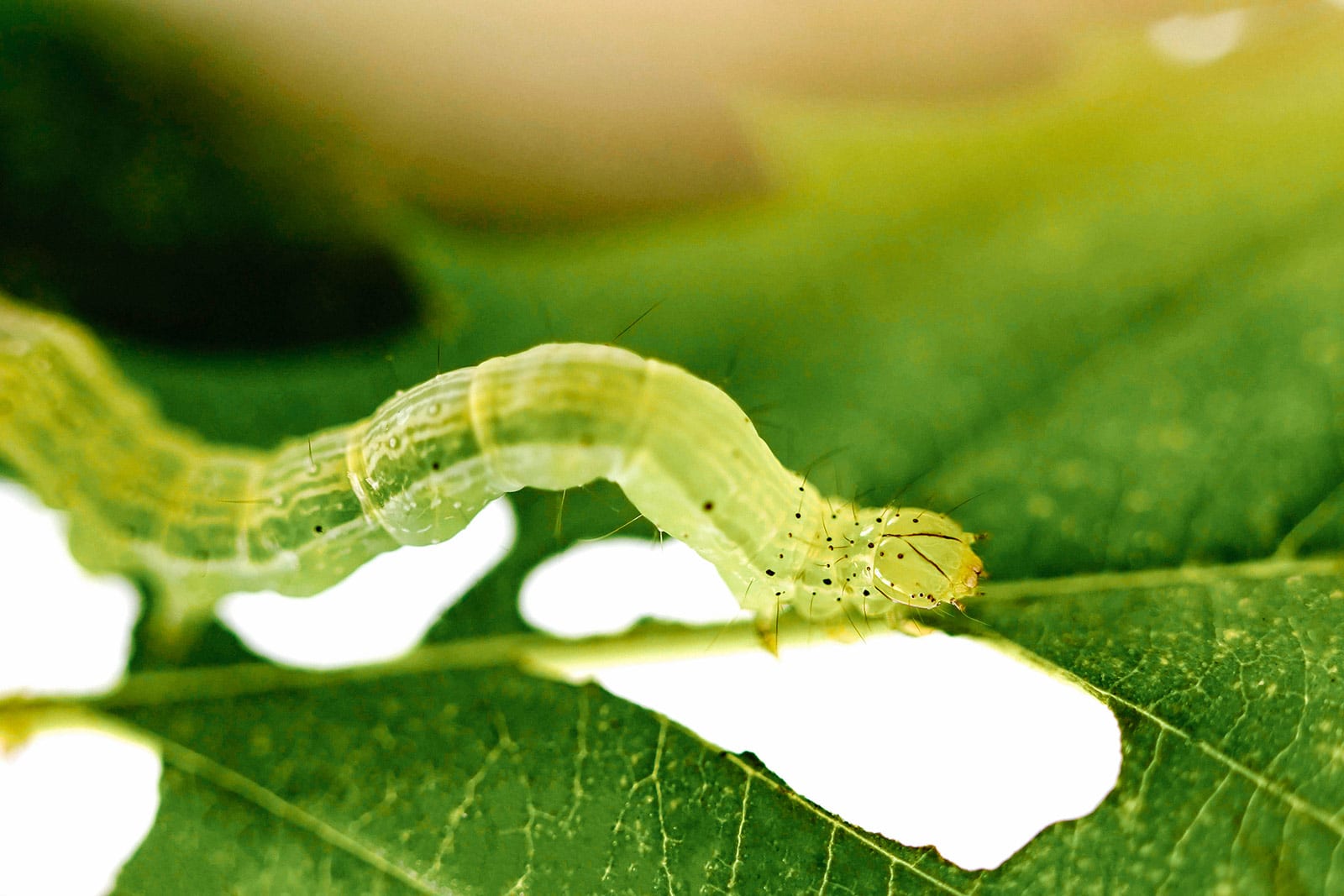
- Scientific name: Hypena scabra
- Turns into: Green cloverworm moth (black snout)
- Found in: North America from Canada south to Texas and Florida, and Great Britain
Green cloverworms have slender, pale green bodies with one or two white stripes extending down each side, and three pairs of prolegs in the middle of their bodies.
When touched, the caterpillars wiggle violently in defense, but are otherwise harmless.
Despite being fairly small at around 2.5 to 3 centimeters (1 to 1.2 inches) long, green cloverworms are quite destructive to commercial soybean crops and other legumes such as clover, alfalfa, beans, cowpeas, and vetch.
The larvae feed in the middle of the leaves of these plants, rather than on the edges, but seldom cause lasting damage to crops since green cloverworms are susceptible to disease and attacks by parasites and pathogens.
Hackberry emperor caterpillar
- Scientific name: Asterocampa celtis
- Turns into: Hackberry emperor butterfly
- Found in: United States into eastern Canada and as far south as central Mexico
The hackberry emperor caterpillar has a light green body with tiny yellowish-white bumps all over. These bumps are arranged in such a way to form narrow stripes down the back and sides. On the rear, it has two small pointy tails.
The bottom of the caterpillar’s head is green with short green spines, while the top of its head is brown with a pair of black horns.
Hackberry emperor caterpillars can grow up to 4 centimeters (1.5 inches) long and their discreet coloring helps them stay camouflaged among green foliage, allowing them to go unnoticed for long periods of time.
They get their name from their only host plant, the hackberry tree, where the butterflies lay their eggs and the larvae feed on the leaves.
Hickory horned devil caterpillar
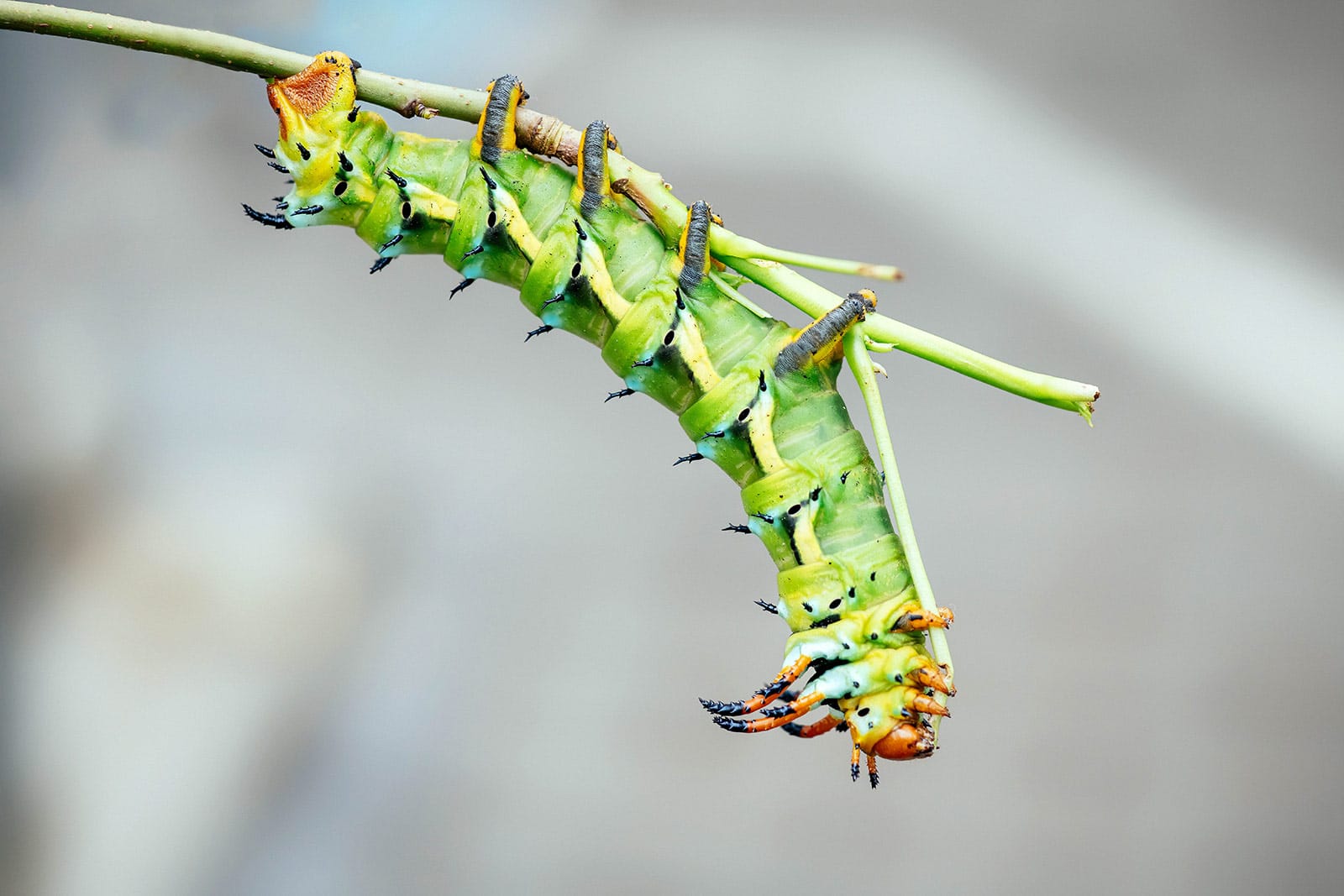
- Scientific name: Citheronia regalis
- Turns into: Regal moth
- Found in: Eastern United States
Hold on to your hats, this caterpillar is quite a sight! The hickory horned devil caterpillar might sound and look a little scary, but it poses no risk to humans and can safely be handled.
It has a brown head, a dark green body covered in black spines, and black prolegs. The two body segments toward the front have four long horn-like projections each that are brown at the base and black at the tip. These eight horns curve back and appear to have little spikes on them, giving the caterpillar its fierce appearance and name.
But what makes it even more astounding is its mature size: The caterpillar starts out tiny but continues to molt and grow and in a matter of weeks, reaches an average size of 15 centimeters (that’s 6 inches!) long with “horns” that are sometimes 2 centimeters (3/4 inch) long. This makes it the largest caterpillar in the United States! (About the size of a large hot dog, in case you’re wondering.)
The imposing larvae can be found on various trees including hickory, walnut, pecan, sweetgum, persimmon, and sumac.
Imperial moth caterpillar

- Scientific name: Eacles imperialis
- Turns into: Imperial moth
- Found in: Eastern and southern United States
The imperial moth caterpillar can be a bit tricky to identify, as its coloring can either be green or brown, depending on genetics and host plants. Caterpillars that feed on pine are more likely to be green, while others may start out as brown and turn green after one molt, or even revert to brown at the next molt.
Fine white hairs cover the entire body and a line of yellowish-white dots with black outlines extend down each side.
While not as large as the hickory horned devil caterpillar, this one is still a biggie: The imperial moth caterpillar can reach a mature size of 10 centimeters (5.5 inches) long.
Common host plants for the larva include oaks, pines, maples (including boxelder), sweetgum, and sassafras.
Io moth caterpillar
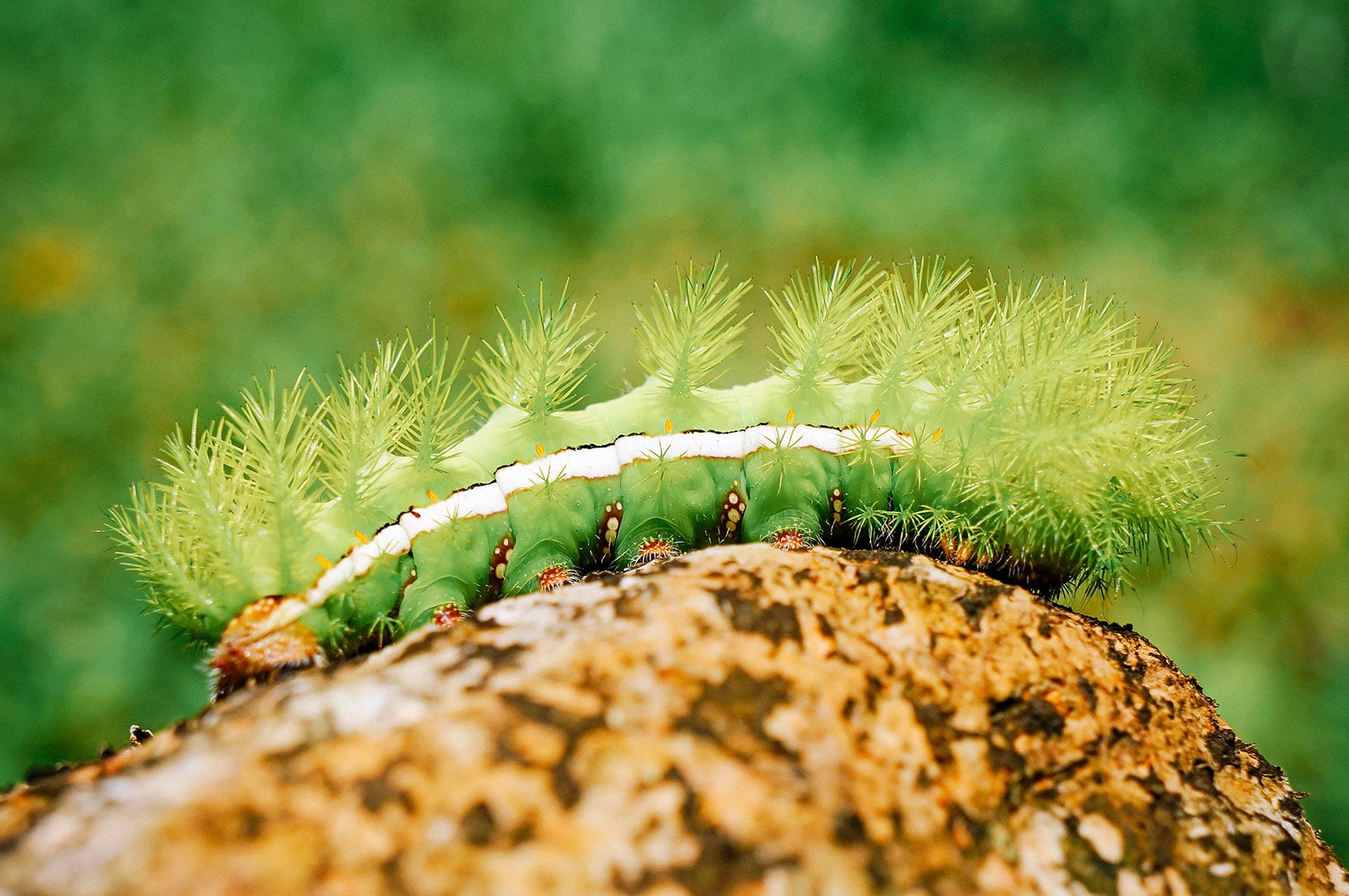
- Scientific name: Automeris io
- Turns into: Io moth (peacock moth)
- Found in: Maine west across southern Canada to southeastern Manitoba, the Dakotas, Nebraska, and Colorado, south to the Florida Keys, Gulf states, Texas, and New Mexico, and Mexico south to Costa Rica
The io moth caterpillar is one of the more well-known caterpillars because of its painful sting—a sensation likened to that of a bad bee sting, and one that can last several hours. So if you see one, definitely avoid touching it!
It has a light green body covered with lots of little green spines that are connected to poison glands. Each cluster of spines almost looks like a little pine tree. Another key identifier for the io moth caterpillar is the distinctive red and white “racing” stripe that runs down the length of the body on each side.
Io moth larvae feed on a variety of trees and shrubs including hackberry, willow, mesquite, redbud, wisteria, sassafras, hibiscus, currant, blackberry, cherry, and pear.
Luna moth caterpillar
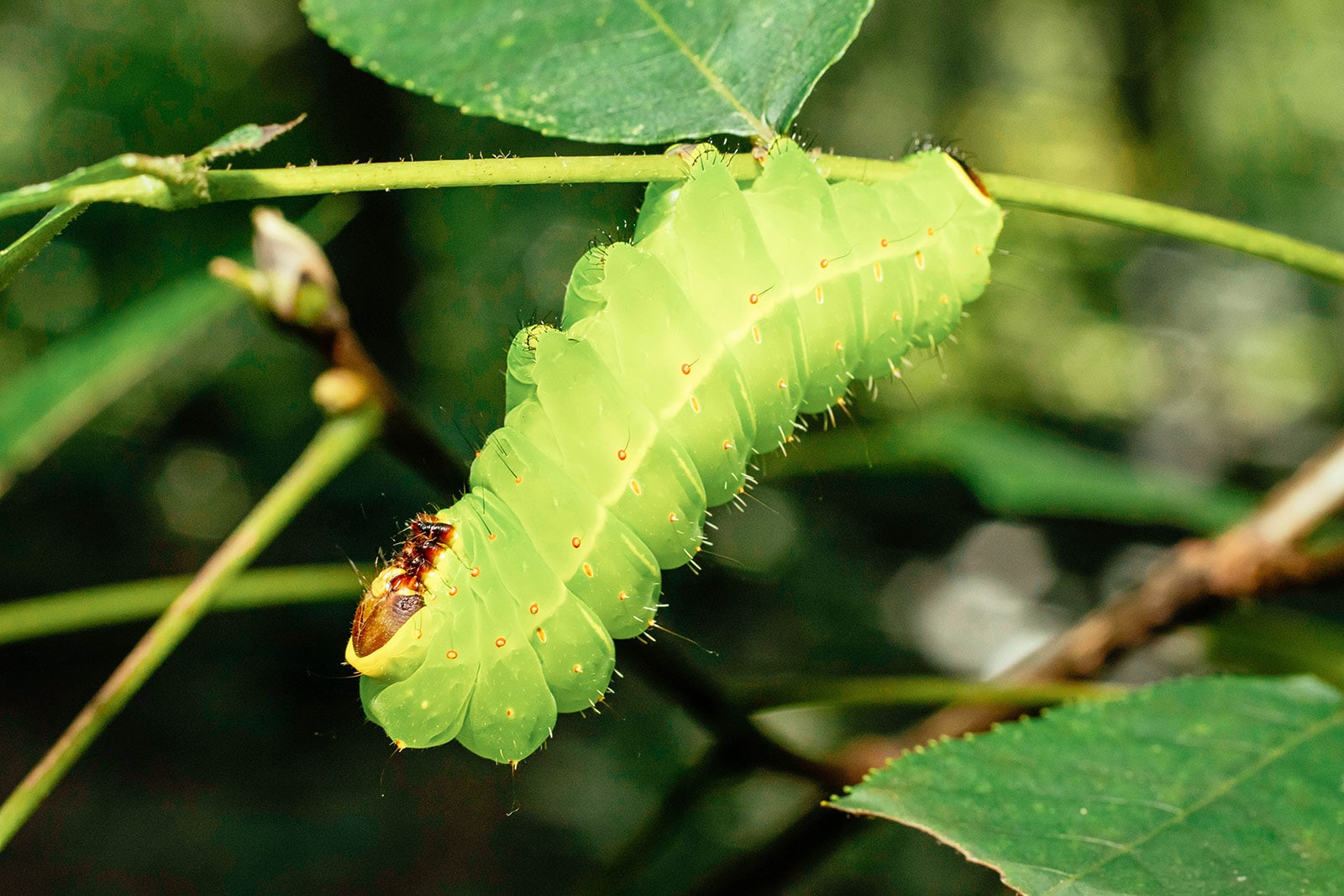
- Scientific name: Actias luna
- Turns into: Luna moth (American moon moth)
- Found in: Florida to Maine, and from Saskatchewan eastward through central Quebec to Nova Scotia in Canada
The luna moth caterpillar is a large species of green caterpillar that differs from other green caterpillars in that it has a distinctly ridged body versus a smooth body.
It’s a plump specimen, growing to about 9 centimeters (3.5 inches) long. At maturity, the luna moth caterpillar is lime green with a series of yellow lines and reddish-orange bumps all over. Thin black spines emerge from these bumps, and while they may look painful, the spines are harmless to humans.
Luna moth larvae feed on a variety of trees, including alder, birch, beech, red maple, white oak, wild cherry, hickory, hazelnut, pecan, walnut, sweetgum, willow, smooth sumac, and persimmon.
Oleander hawk moth caterpillar

- Scientific name: Daphnis nerii
- Turns into: Oleander hawk moth (army green moth)
- Found in: Hawaii, southern Europe, Africa, and Asia
The oleander hawkmoth caterpillar was introduced to Hawaii in the 1970s and while it’s rarely seen on the mainland, there have been scattered reports of the caterpillar in the eastern United States.
You won’t miss it if you pass one: Oleander hawkmoth caterpillars are extremely large, measuring up to 13 centimeters (about 5 inches) long at maturity. They have apple green bodies with white and blue freckling, as well as white stripes down the sides, a row of black spots below each stripe, and a set of false “eyes” that give it a more intimidating look to thwart predators.
As you may have guessed, the larvae feed mainly on oleander leaves, but can also be found on most members of the dogbane family, including periwinkle, desert rose, and pinwheel flowers.
Rosy maple caterpillar (green-striped mapleworm)
- Scientific name: Dryocampa rubicunda
- Turns into: Rosy maple moth
- Found in: Eastern United States to southeastern Canada
The rosy maple caterpillar (also known as the green-striped mapleworm) is hard to miss with its neon green coloring. Black dots and faint white stripes extend the length of the body. As the caterpillar matures, short black spines emerge from the black dots.
It has a reddish-orange head with two black antennae perched on top and a streak of red on the rear. This is a medium-sized caterpillar, growing to be around 5 centimeters (2 inches) long.
True to their name, rosy maple larvae feed on maples, their host plants. Occasionally they can also be found on oak trees.
Rough prominent moth caterpillar (green oak caterpillar)
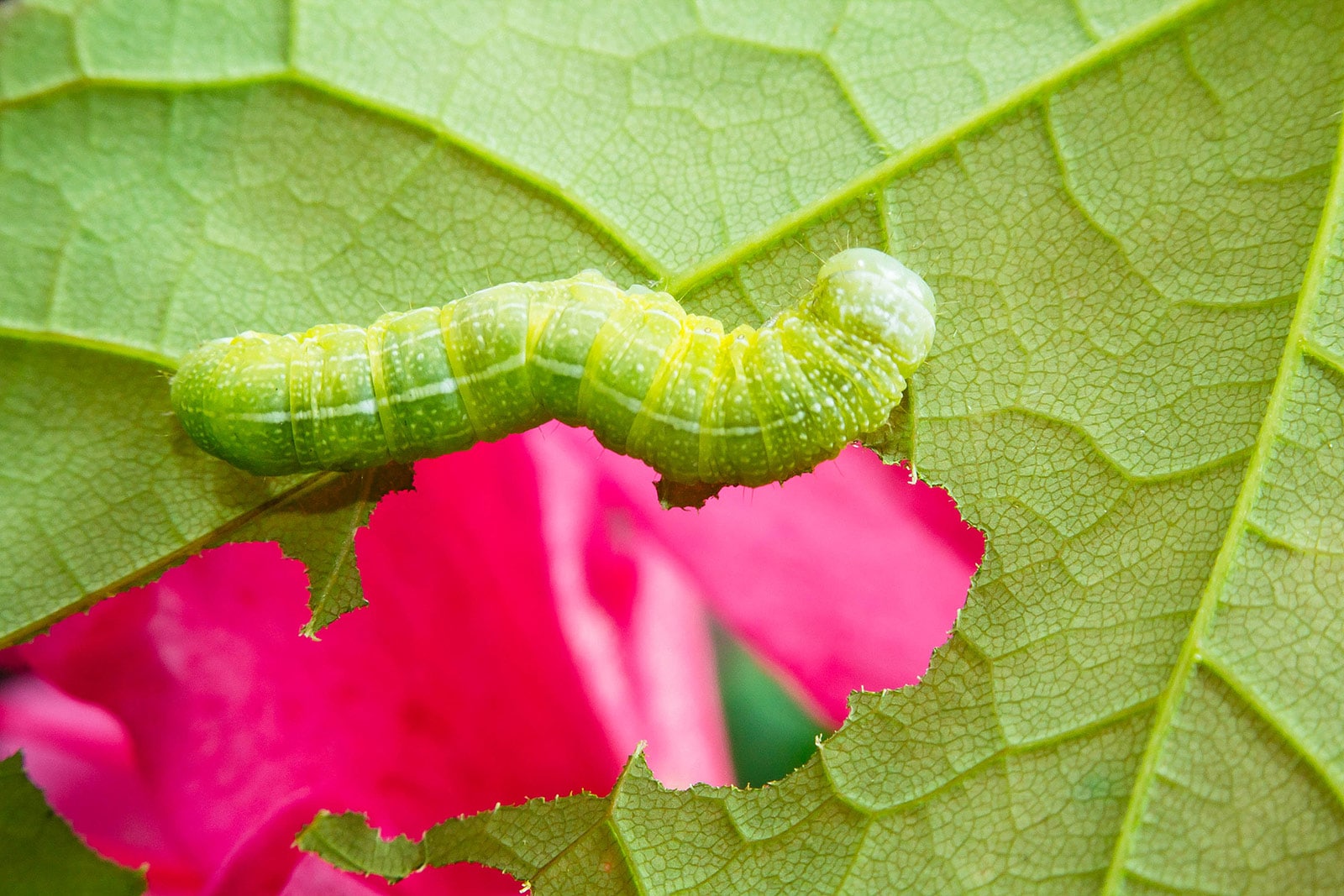
- Scientific name: Nadata gibbosa
- Turns into: Rough prominent moth (white-dotted prominent moth)
- Found in: United States and southern Canada
The rough prominent moth caterpillar (sometimes called the green oak caterpillar) has a body that ranges from blue-green to bright green with teeny-tiny white dots all over. It has a large head capsule, yellow mandibles, and yellow stripes down its body.
This caterpillar is plump and relatively small, growing to be around 1.7 centimeters (0.7 inch) long, so it blends in well with its surroundings.
Its diet mainly consists of oak leaves but it loves to feed on the foliage of alder, birch, and maple trees as well.
Rustic sphinx moth caterpillar (hornworm)
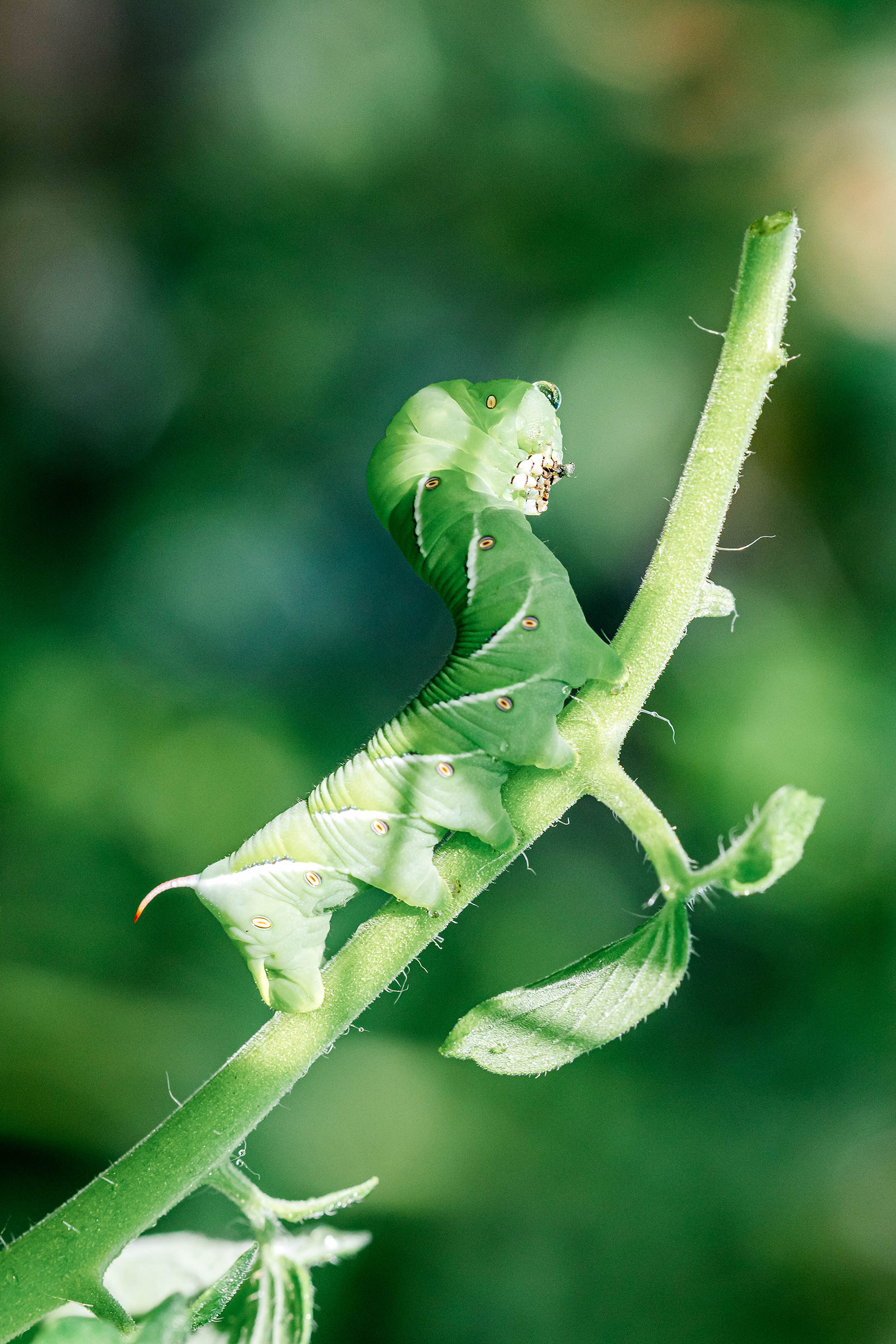
- Scientific name: Manduca rustica
- Turns into: Rustic sphinx moth
- Found in: Southeastern United States north to Virginia and west to Arkansas, Texas, New Mexico, Arizona, and southern California, and south through Central America and South America
The rustic sphinx moth caterpillar has a smooth, bright green body with seven distinctive, diagonal yellow stripes bordered with a dark green to purplish-black, almost like slashes. As the larva nears pupation, it gradually changes color and becomes reddish-brown on top.
It gets its other name (hornworm) from the horn-like protuberances on the posterior end. When threatened, the rustic sphinx caterpillar lifts the front of its body up in defense, resembling the Sphinx in Egypt.
It isn’t too picky about what it eats, as caterpillars have been found feeding on a range of plants, including American beautyberry, crape myrtles, gardenias, desert willows, butterfly bushes, cross vines, heliotrope, jasmine, lantana, ligustrum, lilac, sunflowers, and basil.
Spicebush swallowtail caterpillar
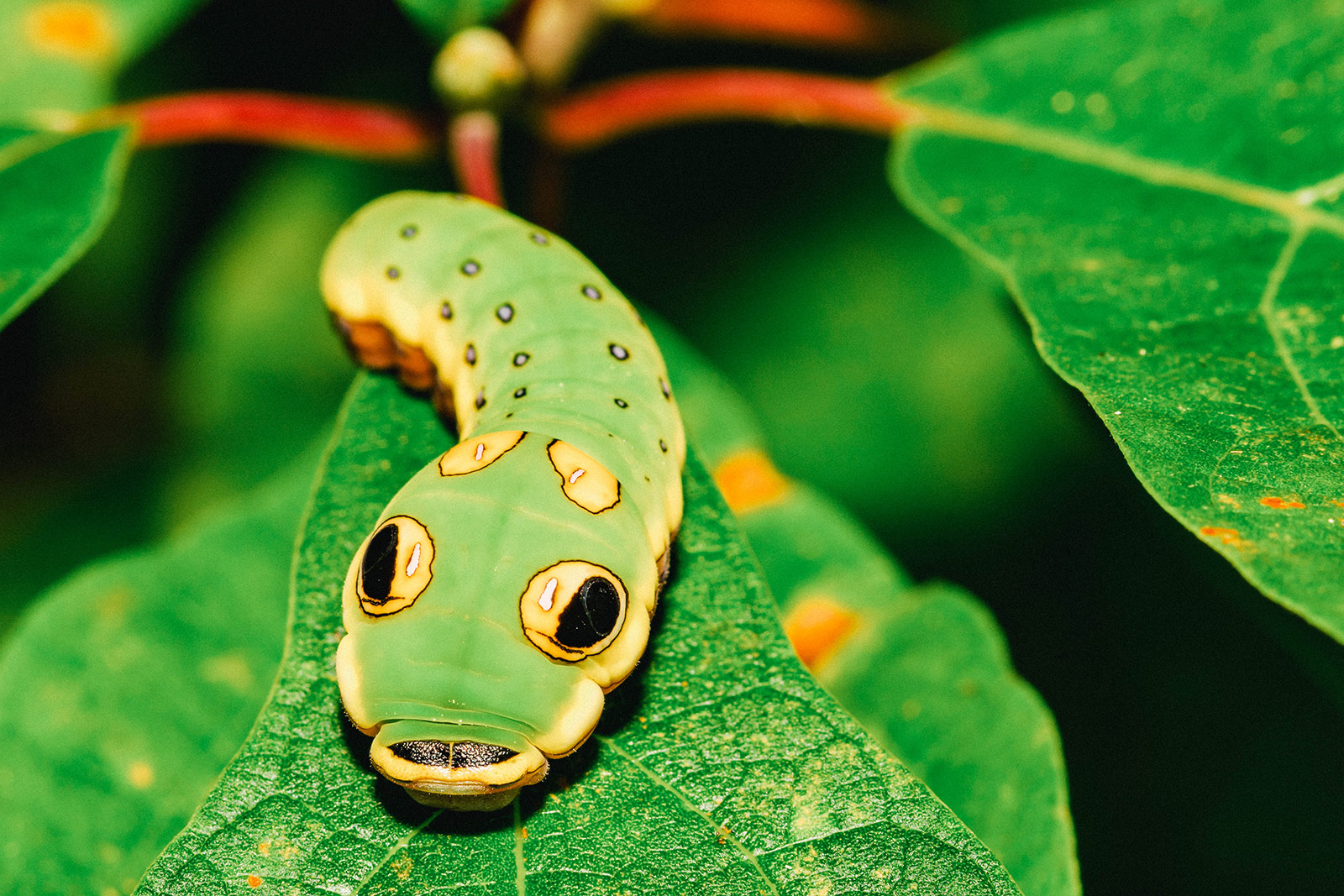
- Scientific name: Papilio troilus
- Turns into: Spicebush swallowtail butterfly
- Found in: Eastern and southern United States
The spicebush swallowtail caterpillar is a real head-turner because at first, it looks like it’s staring straight at you with big beady eyes! In actuality, those “eyes” are just realistic-looking black and yellow markings on the caterpillar’s head that make it look more frightening to potential predators.
Like other swallowtail caterpillars, this one has a gland called an osmeterium that extends like two horns when it’s feeling threatened, sending out a foul-smelling (and tasting) odor to deter attacks. On the spicebush swallowtail caterpillar, the osmeterium looks like an open mouth when resting, but a forked tongue when activated, further adding to its snake-like illusion.
One of the larger caterpillars on this list, the spicebush swallowtail caterpillar can grow to be between 6 to 9.5 centimeters (2.5 to 3.8 inches) long and it has a plump, bright green body with rows of small blue dots outlined in black.
Spicebush swallowtail larvae feed on spicebush, sassafras, and sometimes prickly ash, sweetbay, camphor, and redbay, and tulip trees.
Spiny oak slug caterpillar

- Scientific name: Euclea delphinii
- Turns into: Spiny oak slug moth
- Found in: Quebec and New Brunswick in Canada, south to Florida, west to Texas, and north to Minnesota
The spiny oak slug caterpillar has a unique and easily recognizable appearance. The slug-like body is pale green, oval, and slightly flattened in shape with a series of red, orange, and/or yellow markings down the back, and spiny orange or yellow projections along the back and sides.
These venomous spines can embed themselves into the skin if you touch them, causing reactions that range from redness and mild itching to severe irritation and burning (and sometimes requiring medical attention).
Spiny oak slug caterpillars also have three pairs of horn-like, dark-tipped bristly spines at the front, and two more pairs of horn-like spines at the rear. If you spot one of these caterpillars, admire it from a distance and do not try to pick it up!
It’s one of the smaller types of green caterpillars on this list as it grows to just 2 centimeters (0.8 inches) long, but the bright colors make its features easy to see.
Host plants for the larvae include a variety of deciduous trees (not just oak), including maple, willow, redbud, sycamore, chestnut, cherry, apple, plum, and more.
Tiger swallowtail caterpillar
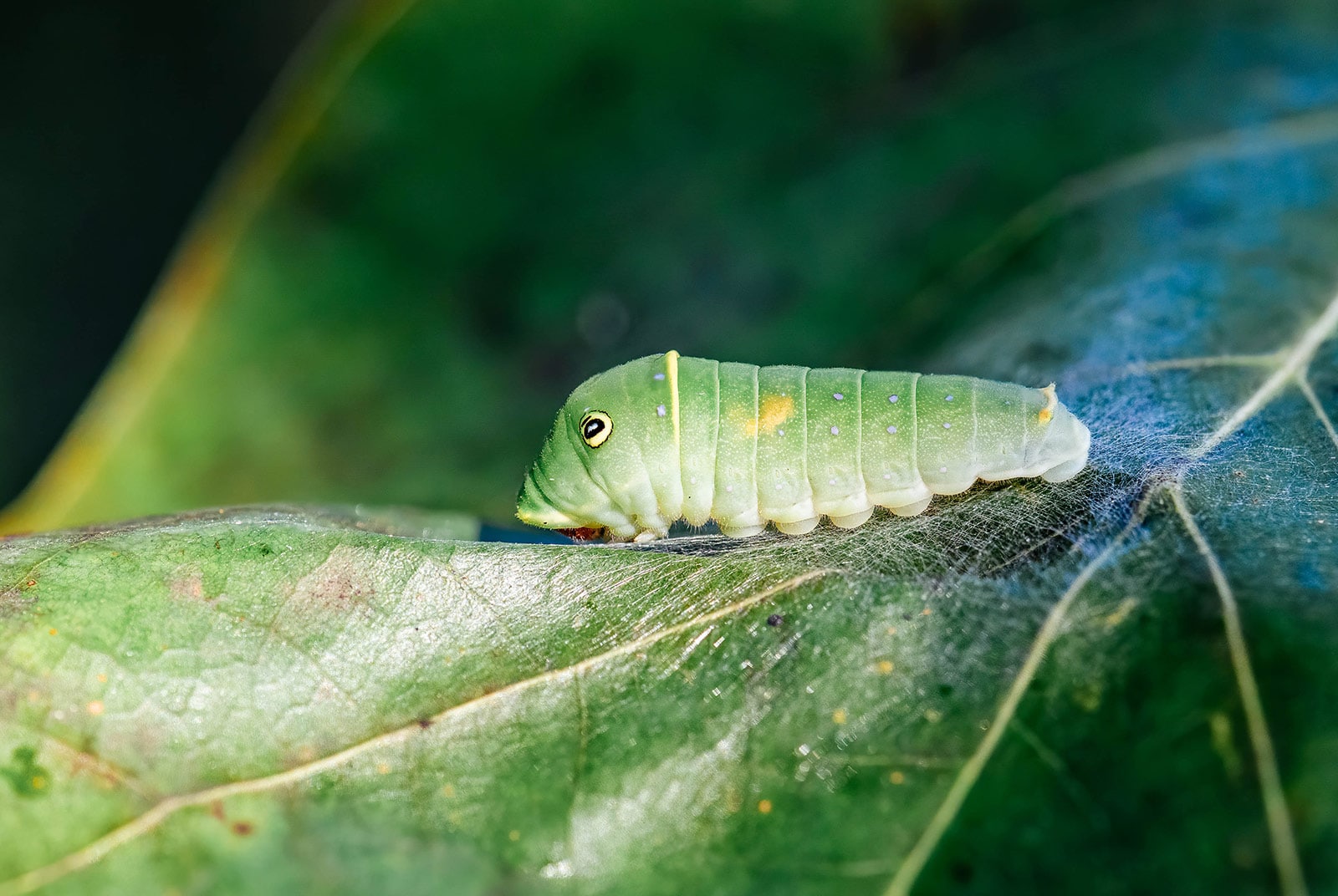
- Scientific name: Papilio glaucus
- Turns into: Tiger swallowtail butterfly
- Found in: Eastern United States to the Great Plains
A lot of swallowtail caterpillars look similar, so it’s easy to mistake them for each other. The tiger swallowtail caterpillar looks like a spicebush swallowtail caterpillar at first glance with its plump green body and eye spots, but the “eyes” on its head are much less prominent.
The eye-like markings appear as yellow spots with tiny black dots in the center. It also has a thin yellow band around its body near the front, which is concealed between the folds of the segments when the caterpillar is at rest.
An osmeterium (defensive gland) protrudes from the front like a forked orange tongue when the tiger swallowtail caterpillar is being attacked. This gland emits a foul odor and makes the caterpillar less palatable to birds and other predators.
Tiger swallowtail caterpillars grow up to 5.5 centimeters (2.2 inches) long and feed on a variety of host plants from the Magnoliaceae and Rosaceae families, including tulip trees, sweet bay magnolias, wild black cherries.
Tobacco hornworm
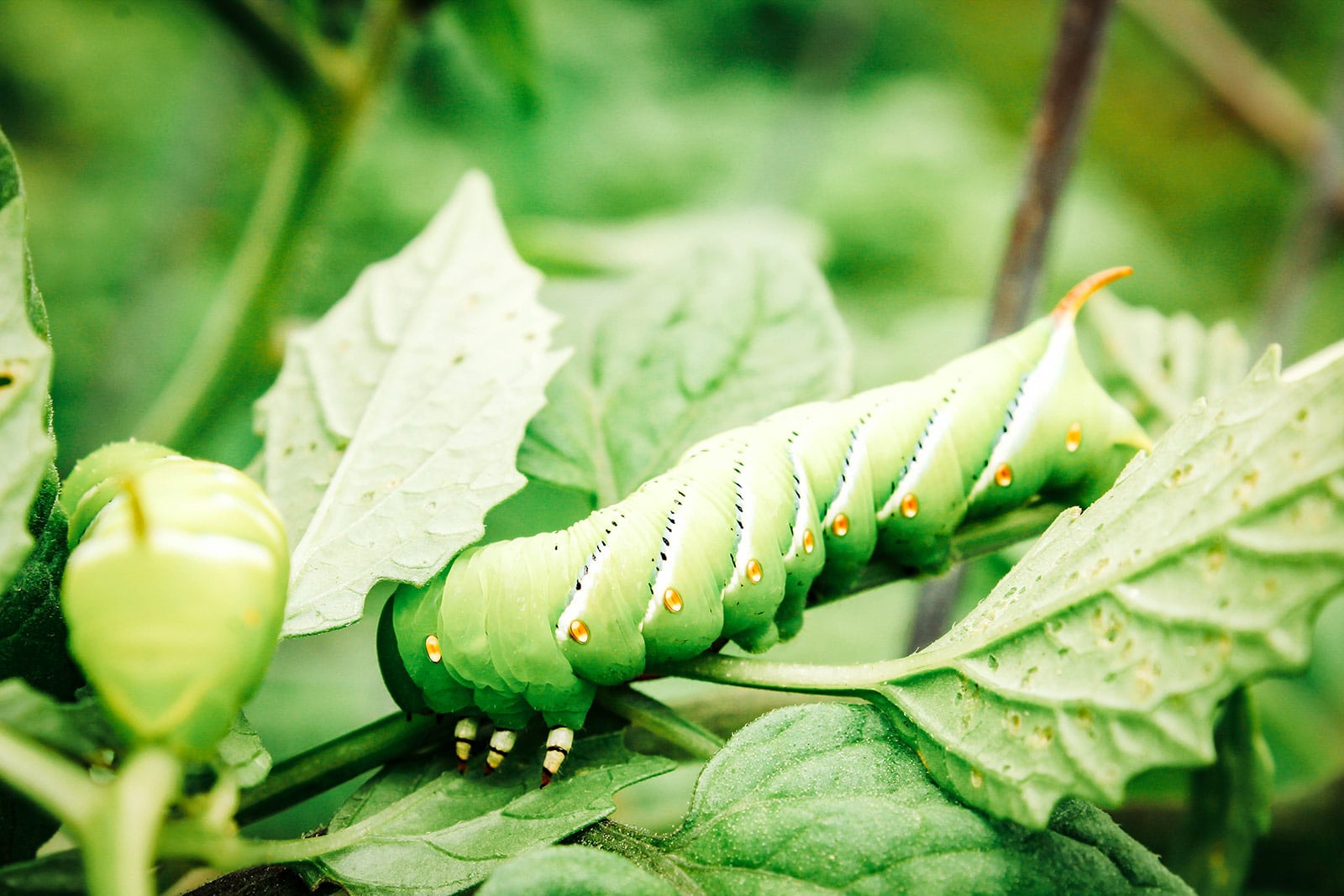
- Scientific name: Manduca sexta
- Turns into: Carolina sphinx moth
- Found in: Southern Canada, United States (particularly in the southeast), Central America, and the Caribbean
The tobacco hornworm has a robust green body with seven diagonal white stripes that are edged in black on one side and have black and yellow spots on the other side.
While it’s harmless to humans, the tobacco hornworm has a characteristic reddish-orange horn at the rear meant to intimidate potential predators.
Tobacco hornworms are known to feed on and cause a lot of damage to various crops from the nightshade family, especially tomato plants, which makes it easy to misidentify them for tomato hornworms (which I discuss just below).
However, you can spot the differences in the number and color of their lateral markings, as well as the color of their horns. Always count the number of white stripes and look at the color of the horns, as I’ve found many, many pictures online (even from reputable sources) that are mislabeled as tomato hornworms when they are, in fact, tobacco hornworms.
Tobacco hornworms can grow to be around 7 centimeters (2.7 inches) long, making them one of the largest green caterpillars you may come across in your vegetable garden.
Tomato hornworm
- Scientific name: Manduca quinquemaculata
- Turns into: Five-spotted hawk moth
- Found in: North America from southern Canada to northern Mexico
If you grow your own food, chances are you’ve come across a tomato hornworm at some point in your gardening. The tomato hornworm is one of the more invasive species of green caterpillar and has garnered a reputation for its ravenous appetite on tomato crops all over the country.
Mature caterpillars can be identified by their plump, bright green bodies, which have a series of eight white diagonal slashes down each side that are shaped more like chevrons (or sideways Vs). The “horn” on tomato hornworms are black or bluish-black (instead of red).
Tomato hornworms are one of the largest caterpillars, reaching up to (4 inches) long.
Tomatoes are the host plant of choice, but the larvae also feed on other nightshades such as potatoes, eggplants, and peppers.
White-lined sphinx moth caterpillar
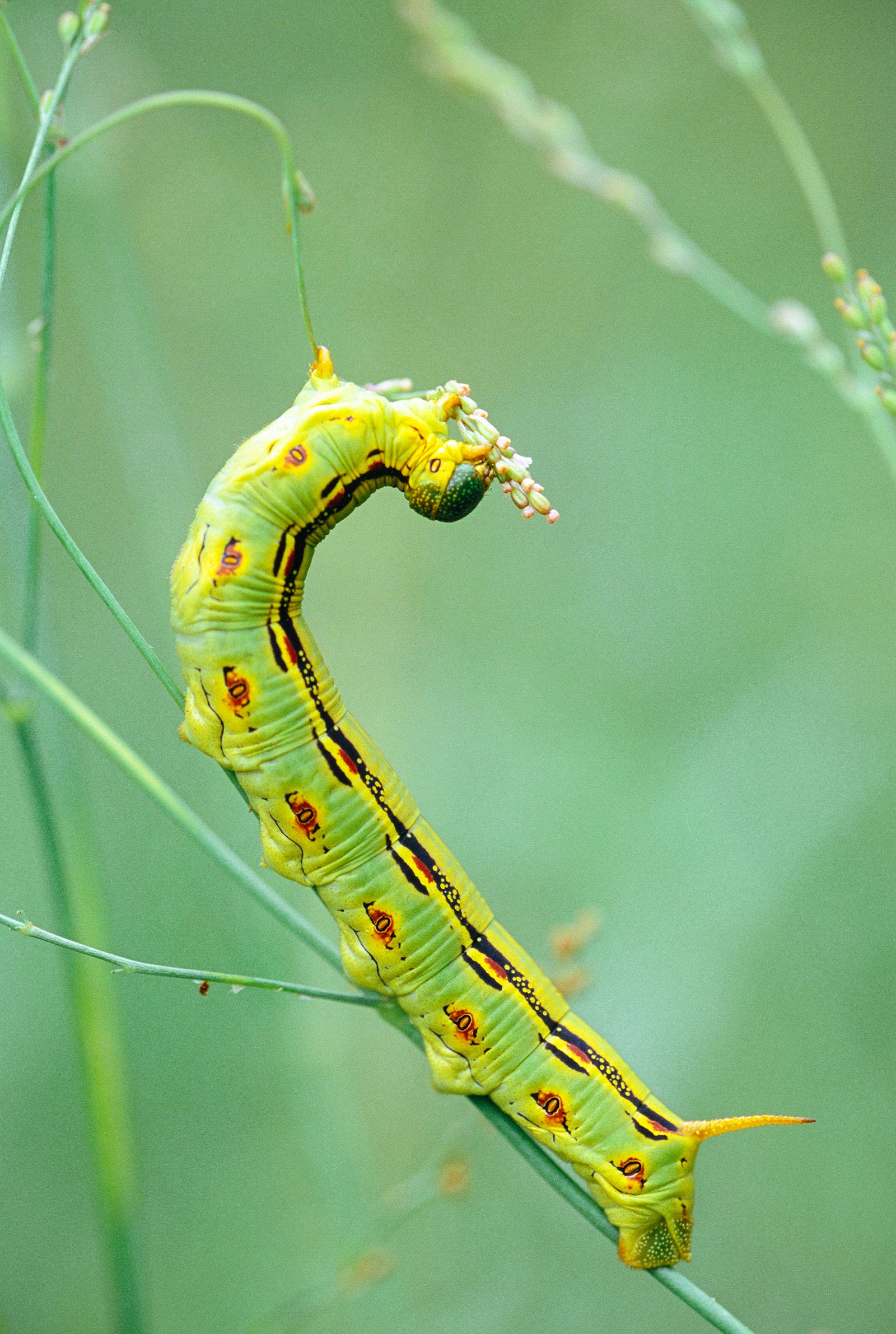
- Scientific name: Hyles lineata
- Turns into: White-lined sphinx moth
- Found in: Central America through Mexico and the West Indies to most of the United States and southern Canada
The white-lined sphinx moth caterpillar is a type of hornworm that’s variable in color. Its stout body ranges from lime green to dark green, with a series of black lengthwise stripes along with yellow and orange spots along the sides.
It also has a pointed horn at the back end that can either be yellow or orange, sometimes with a black tip. While it may look like a stinger, this “horn” and the caterpillar itself is harmless to humans.
White-lined sphinx caterpillars can grow to be quite large, reaching 9 centimeters (about 3.5 inches) in length.
The larvae feed on a wide range of host plants, including willow weed, evening primrose, fuchsia, four o’clocks, purslane, tomatoes, and grapes.
Winter moth caterpillar
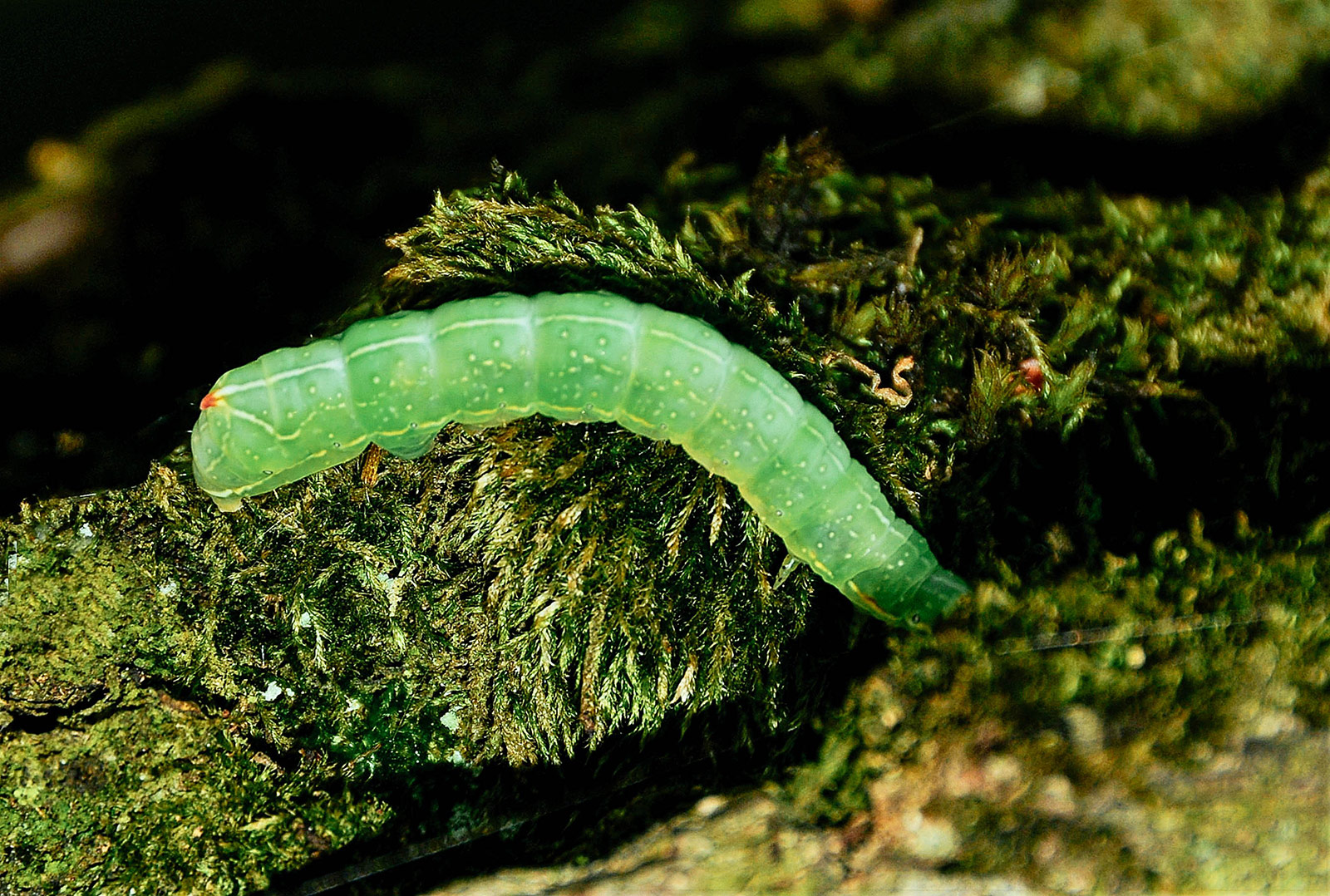
- Scientific name: Operophtera brumata
- Turns into: Winter moth
- Found in: Northeastern United States
The winter moth caterpillar is a type of inchworm that only grows to be about an inch (2.5 centimeters) long.
Known to be an incredibly invasive species, winter moth caterpillars are pale green with narrow white stripes running lengthwise down each side of their bodies.
Winter moth larvae can be found feeding on the leaves and buds of deciduous woody plants, such as elms, oaks, maples, mountain ash, and flowering cherries, as well as most fruit trees and shrubs.


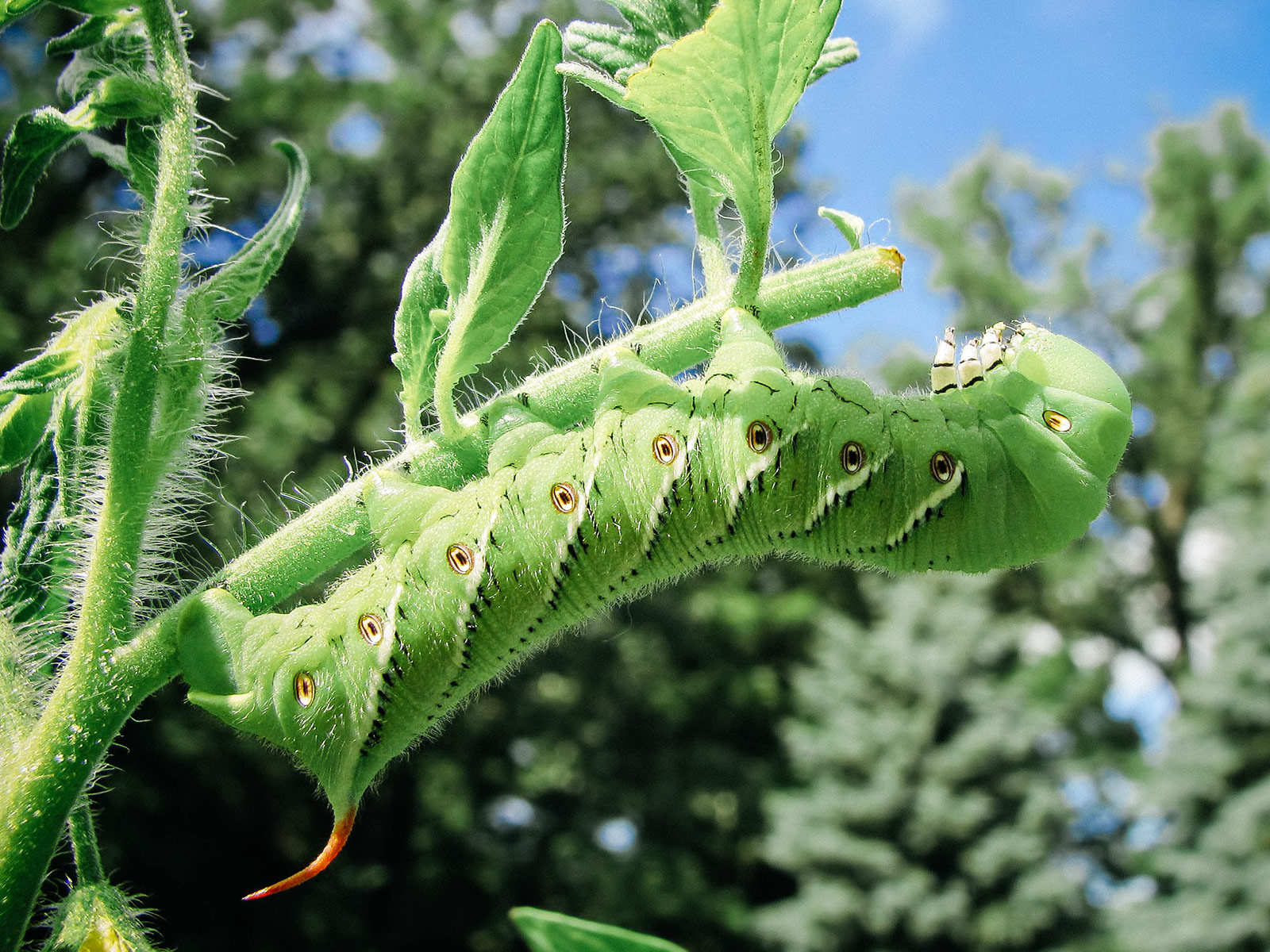
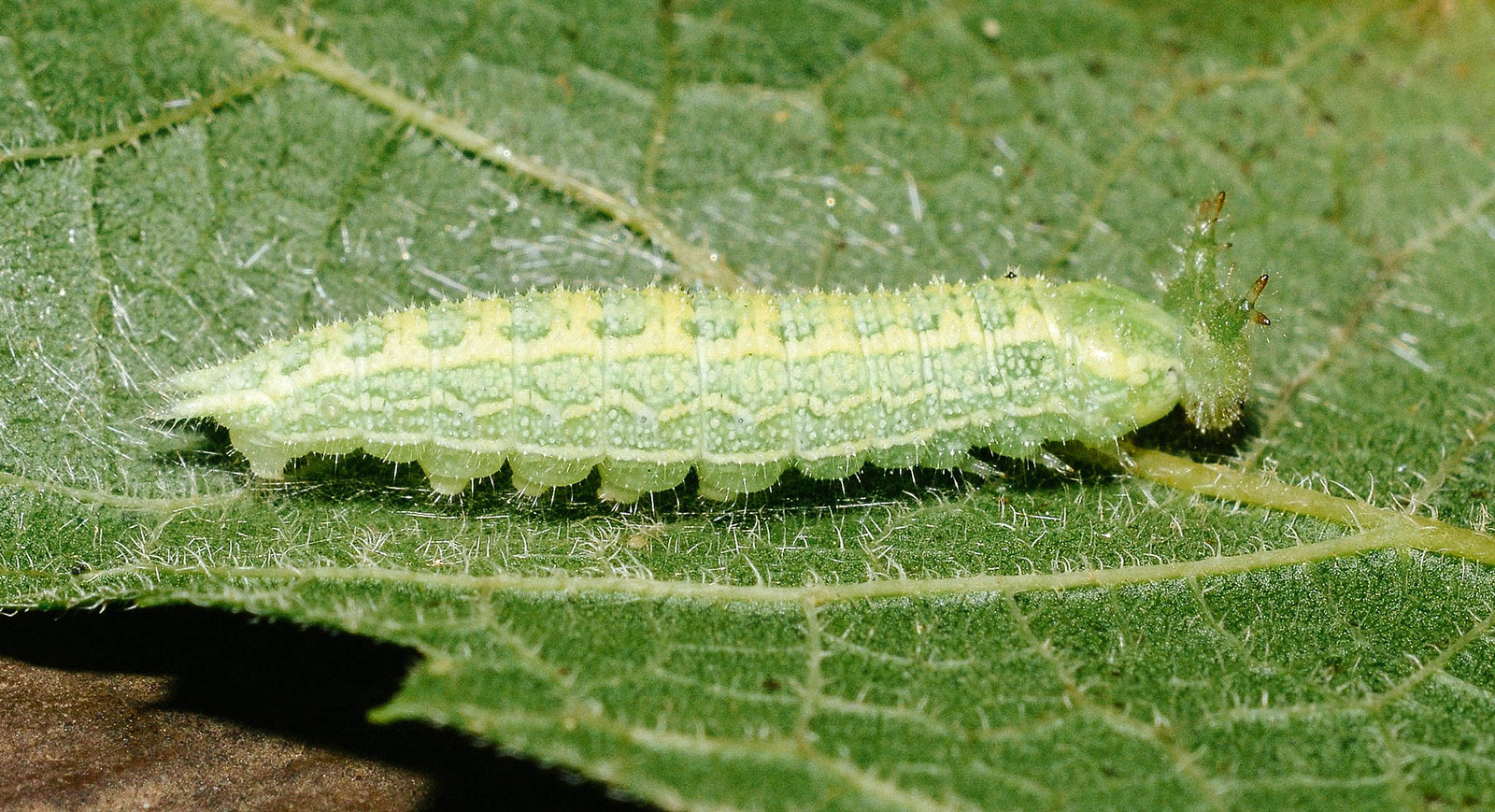
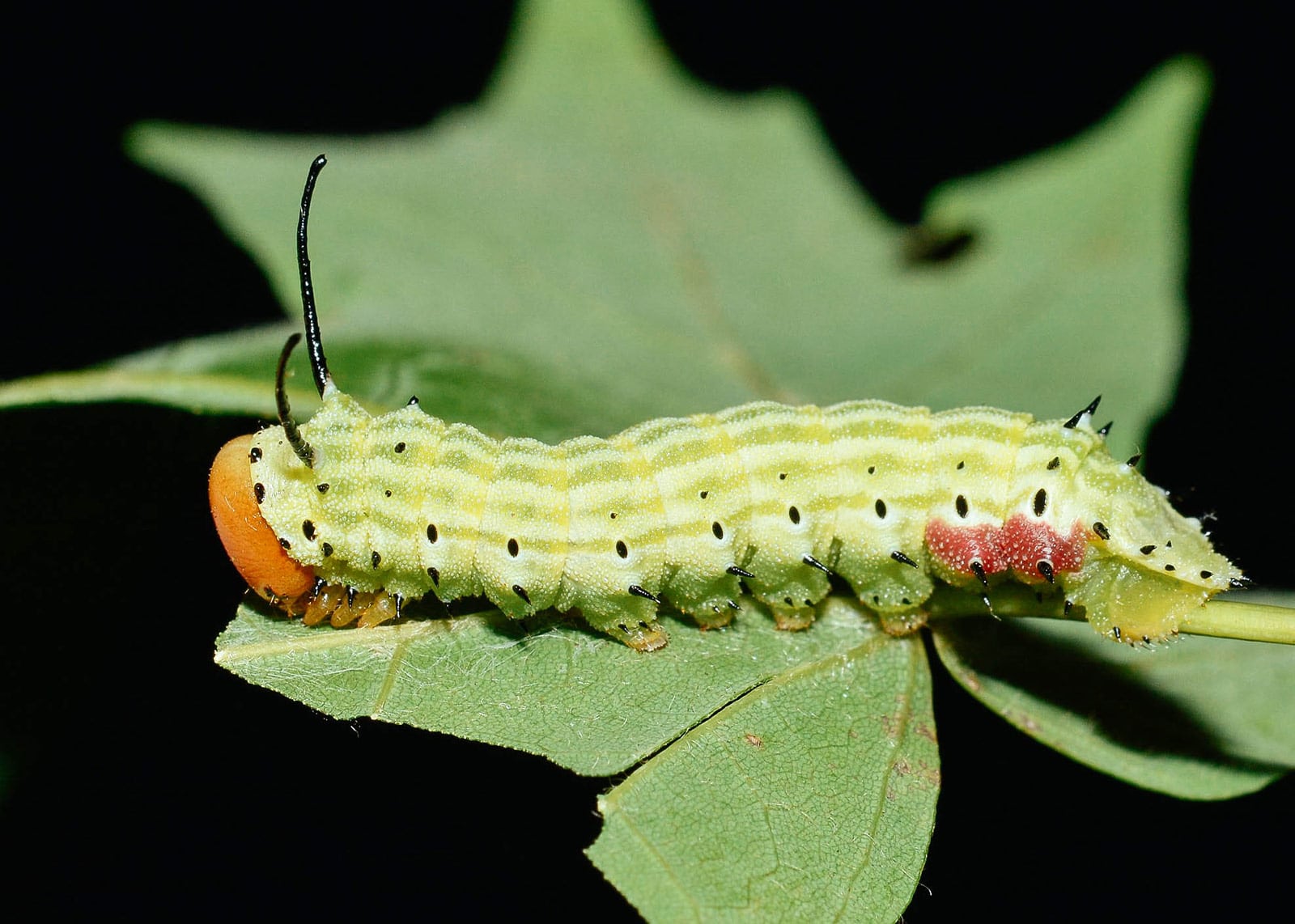
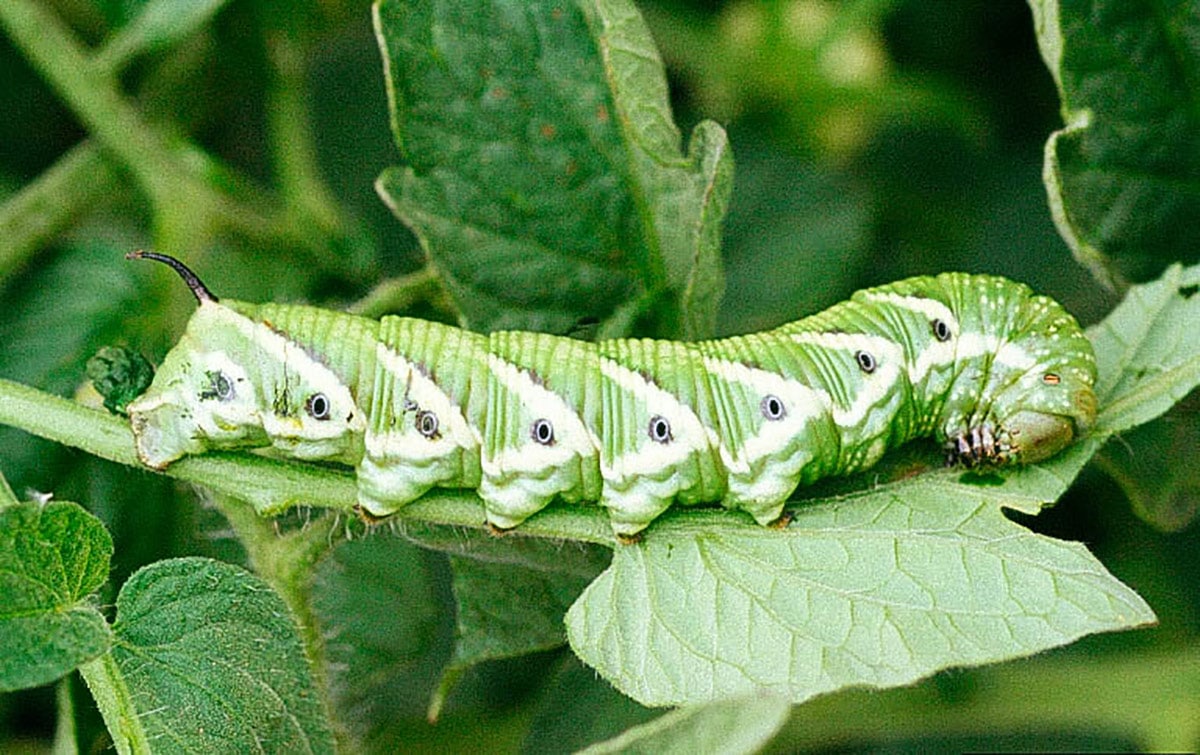













Your Black Swallowtail Caterpillar is wrong, I believe it is a Monarch Butterfly Caterpillar but it is NOT a Black Swallowtail Butterfly caterpillar, as they are red and black. I know, because I raise them. 🙂
That is 100% a black swallowtail caterpillar. You can see an image of a monarch caterpillar in my other post about striped caterpillars: https://gardenbetty.com/striped-caterpillars/
I’m guessing your red and black caterpillars might be early instars of the black swallowtail? As do they start off those colors before turning green in their final caterpillar stage.
Thank You for the reply. Then I must be thinking of the Blue Swallowtail aka Pipevine Swallowtail. We were taught in school that this was the Black Swallowtail. The Blue Swallowtails have completely different looking Caterpillars. Thanks again for the reply! I stand corrected!
I have a Elphant Hawk Moth in my garden just looked it up as it doesn’t look like any caterpillar I have seen
Linda Ly: What an excellent caterpillar compendium! My only suggestion would be to include more beautiful photos of the adult moths and butterflies in version 2.
I have a picture of some kind of caterpillar,I’m in NC it’s not any of the ones on this list
Small, very tiny fuzzy green caterpillar spiked me today. Any worry?
Definitly you should worry. One of those truckers got me the other day and I was out on the ground. Long story short I had to go to the hospital and payed lots of money to get saved.